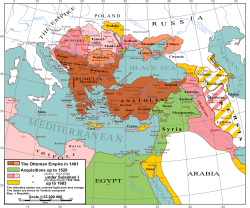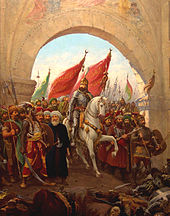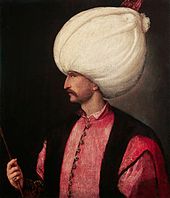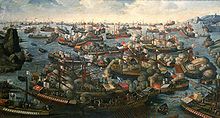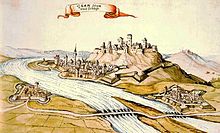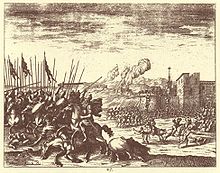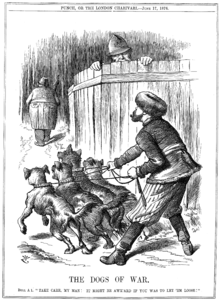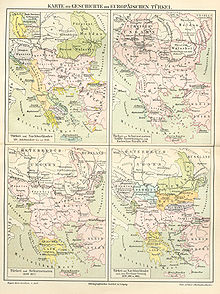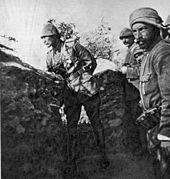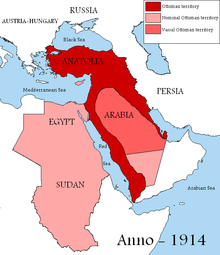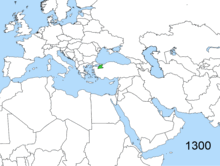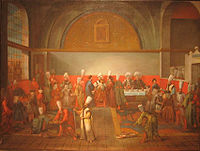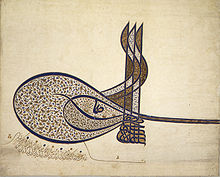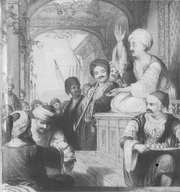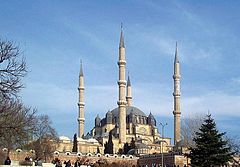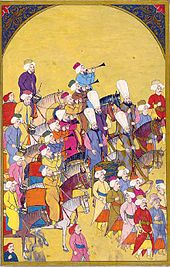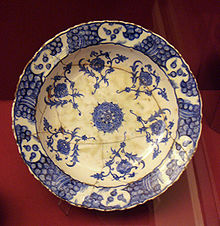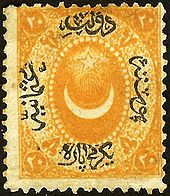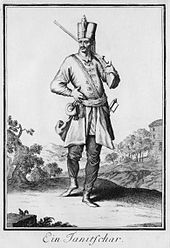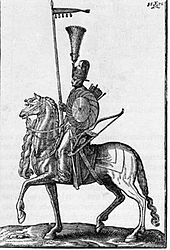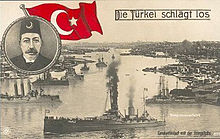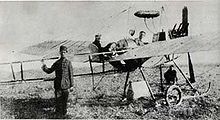- Ottoman Empire
-
History of the Ottoman Empire 
This article is part of a seriesFoundation (1299–1402) Interregnum (1402–1413) Rise (1413–1453) Progress and Accelerated Growth (1453–1579) Diminishing Growth (1579–1683) Sultanate of Women Köprülü Era (1656–1703) Stagnation (1683–1792) Tulip Era (1718–1730) Severe Stagnation - Retrogression
(1792–1827)Decline (1827–1908) Tanzimat Era (1839–1876) 1st Constitutional Era Dissolution (1908–1918) 2nd Constitutional Era Occupation and Partitioning
(1918–1922)
the Ottoman Empire Portal
The Ottoman Empire[dn 4] or Sublime Ottoman State (Ottoman Turkish: دَوْلَتِ عَلِيّهٔ عُثمَانِیّه Devlet-i ʿAliyye-yi ʿOsmâniyye,[7] (also عثمانلى دولتى Osmanlı Devleti),[dn 5] Modern Turkish: Yüce Osmanlı Devleti or Osmanlı İmparatorluğu) which lasted from 27 July 1299[8] to 29 October 1923, is one of 16 Turkish empires established throughout history.[9][10][11]
The Ottoman Empire was one of the largest and longest lasting empires in history. It was an empire inspired and sustained by Islam, and Islamic institutions.[12] At the height of its power, in the 16th and 17th centuries, it controlled territory in southeast Europe, western Asia, and North Africa.[13] The Ottoman Empire contained 29 provinces and numerous vassal states, some of which were later absorbed into the empire, while others were granted various types of autonomy during the course of centuries.[dn 6]
With Constantinople (present-day Istanbul, Ottoman Turkish: استنبول, Istanbul[14] and قسطنطينيه, Kostantiniyye) as its capital city,[15][16] and vast control of lands around the eastern Mediterranean during the reign of Suleiman the Magnificent (ruled 1520 to 1566), the empire was at the center of interactions between the Eastern and Western worlds for six centuries.
The Ottoman Empire came to an end, as a regime under a monarchy, on 1 November 1922.[17] It formally ended, as a de jure state, on 24 July 1923, under the Treaty of Lausanne.[18] The Republic of Turkey, which was officially proclaimed on 29 October 1923, became one of the successor states of the Ottoman Empire[19][20][21][22][23][24][25] as part of the treaty.
Contents
- 1 History
- 2 Fall of the Empire
- 3 Economy
- 4 State
- 5 Society
- 6 Culture
- 7 Demographics
- 8 Law
- 9 Military
- 10 See also
- 11 Footnotes
- 12 References
- 13 Further reading
- 14 External links
History
Rise of the Ottoman Empire (1299–1453)
With the demise of the Seljuk Sultanate of Rum (c. 1300), Anatolia was divided into a patchwork of independent states, the so-called Ghazi emirates. By 1300, a weakened Byzantine Empire had lost most of its Anatolian provinces to ten Ghazi principalities. One of the Ghazi emirates was led by Osman I (from which the name Ottoman is derived), son of Ertuğrul, around Eskişehir in western Anatolia. In the foundation myth expressed in the medieval Turkish story known as "Osman's Dream", the young Osman was inspired to conquest by a prescient vision of empire (according to his dream, the empire is a big tree whose roots spread through three continents and whose branches cover the sky).[26][citation needed] According to his dream the tree, which was Osman's Empire, issued four rivers from its roots, the Tigris, the Euphrates, the Nile and the Danube.[26] Additionally, the tree shaded four mountain ranges, the Caucasus, the Taurus, the Atlas and the Balkan ranges.[26] During his reign as Sultan, Osman I, extended the frontiers of Ottoman settlement toward the edge of the Byzantine Empire. He also moved the Ottoman capital to Bursa, and shaped the early political development of the nation.
In this period, a formal Ottoman government was created whose institutions would change drastically over the life of the empire. The government used the legal entity known as the millet, under which religious and ethnic minorities were allowed to manage their own affairs with substantial independence from central control.
In the century after the death of Osman I, Ottoman rule began to extend over the Eastern Mediterranean and the Balkans. The important city of Thessaloniki was captured from the Venetians in 1387. The Ottoman victory at the Battle of Kosovo in 1389 effectively marked the end of Serbian power in the region, paving the way for Ottoman expansion into Europe. The Battle of Nicopolis in 1396, widely regarded as the last large-scale crusade of the Middle Ages, failed to stop the advance of the victorious Ottomans. With the extension of Ottoman dominion into the Balkans, the strategic conquest of Constantinople became a crucial objective. The Empire controlled nearly all former Byzantine lands surrounding the city, but the Byzantines were temporarily relieved when Timur invaded Anatolia in the Battle of Ankara in 1402. He took Sultan Bayezid I as a prisoner. Part of the Ottoman territories in the Balkans (such as Thessaloniki, Macedonia and Kosovo) were temporarily lost after 1402, but were later recovered by Murad II between the 1430s and 1450s.
The capture of Bayezid I threw the Turks into disorder. The state fell into a civil war that lasted from 1402 to 1413, as Bayezid's sons fought over succession. It ended when Mehmed I emerged as the sultan and restored Ottoman power, bringing an end to the Interregnum. His grandson, Mehmed the Conqueror, reorganized the state and the military, and demonstrated his martial prowess by capturing Constantinople on 29 May 1453, at the age of 21.
Growth (1453–1683)
This period in Ottoman history can roughly be divided into two distinct eras: an era of territorial, economic, and cultural growth before 1566, followed by an era of relative military and political stagnation.
Expansion and apogee (1453–1566)
The Ottoman conquest of Constantinople in 1453 by Mehmed II cemented the status of the Empire as the preeminent power in southeastern Europe and the eastern Mediterranean. After taking Constantinople, Mehmed met with the Orthodox patriarch, Gennadios and worked out an arrangement in which the Orthodox Church, in exchange for being able to maintain its autonomy and land, accepted Ottoman authority.[27] Because of bad relations between the latter Byzantine Empire and the states of western Europe as epitomized by Loukas Notaras's famous remark "Better the Sultan's turban than the Cardinal's Hat", the majority of the Orthodox population accepted Ottoman rule as preferable to Venetian rule.[27]
Mehmed II made Constantinople (present-day Istanbul) the new capital of the Ottoman Empire, and he assumed the title of Kayser-i Rûm (Caesar Romanus = Roman Emperor). The Russian Tsars also claimed to be the successors to the eastern imperial title. To consolidate his claim, Mehmed II wanted to gain control over the Western capital, Rome, and Ottoman forces occupied parts of the Italian Peninsula. They started with the invasion of Otranto and Apulia on 28 July 1480. After Mehmed II's death on 3 May 1481 the campaign in Italy was cancelled and Ottoman forces retreated.
During this period in the 15th and 16th centuries, the Ottoman Empire entered a long period of conquest and expansion, extending its borders deep into Europe and North Africa. Conquests on land were driven by the discipline and innovation of the Ottoman military; and on the sea, the Ottoman Navy aided this expansion significantly. The navy also contested and protected key seagoing trade routes, in competition with the Italian city states in the Black Sea, Aegean and Mediterranean seas and the Portuguese in the Red Sea and Indian Ocean.
The state also flourished economically thanks to its control of the major overland trade routes between Europe and Asia.[28]
The Empire prospered under the rule of a line of committed and effective Sultans. Sultan Selim I (1512–1520) dramatically expanded the Empire's eastern and southern frontiers by defeating Shah Ismail of Safavid Persia, in the Battle of Chaldiran.[29] Selim I established Ottoman rule in Egypt, and created a naval presence on the Red Sea. After this Ottoman expansion, a competition started between the Portuguese Empire and the Ottoman Empire to become the dominant power in the region.[30]
Selim's successor, Suleiman the Magnificent (1520–1566), further expanded upon Selim's conquests. After capturing Belgrade in 1521, Suleiman conquered the southern and central parts of the Kingdom of Hungary. (The western, northern and northeastern parts remained independent.)[31][32]
 Barbarossa Hayreddin Pasha defeated the Holy League of Charles V under the command of Andrea Doria at the Battle of Preveza in 1538 (painted 1866).
Barbarossa Hayreddin Pasha defeated the Holy League of Charles V under the command of Andrea Doria at the Battle of Preveza in 1538 (painted 1866).
After his victory in the Battle of Mohács in 1526, he established Ottoman rule in the territory of present-day Hungary (except the western part) and other Central European territories, (See also: Ottoman–Hungarian Wars). He then laid siege to Vienna in 1529, but failed to take the city after the onset of winter forced his retreat.[33]
In 1532, he made another attack on Vienna, but was repulsed in the Siege of Güns, 97 kilometres (60 mi) south of the city at the fortress of Güns.[34][35][36] In the other version of the story, the city's commander, Nikola Jurišić, was offered terms for a nominal surender.[37] However, Suleiman withdrew at the arrival of the August rains and did not continue towards Vienna as previously planned, but turned homeward instead.[37][38]
After further advances by the Ottomans in 1543, the Habsburg ruler Ferdinand officially recognized Ottoman ascendancy in Hungary in 1547. During the reign of Suleiman, Transylvania, Wallachia and, intermittently, Moldavia, became tributary principalities of the Ottoman Empire. In the east, the Ottomans took Baghdad from the Persians in 1535, gaining control of Mesopotamia and naval access to the Persian Gulf. By the end of Suleiman's reign, the Empire's population totaled about 15,000,000 people.[39]
Suleiman's expansion into the Central Mediterranean was however halted in Malta in 1565. During a summer-long siege which was later to be known as the Siege of Malta, the Ottoman forces which numbered around 50,000 fought the Knights of St.John and the Maltese garrison which in total numbered around 6,000. Stubborn resistance by the Knights and the Maltese as well as infighting between the Turkish leaders led to the lifting of the Siege in September. The Ottomans' defeat in Malta in 1565 was the second and last one experienced by Suleiman the Magnificent, after the Ottoman defeat in Vienna in 1529.
Under Selim and Suleiman, the Empire became a dominant naval force, controlling much of the Mediterranean Sea.[40] The exploits of the Ottoman admiral Barbarossa Hayreddin Pasha, who commanded the Ottoman Navy during Suleiman's reign, led to a number of military victories over Christian navies. Among these were the conquest of Tunis and Algeria from Spain; and the capture of Nice from the Holy Roman Empire in 1543.
This last conquest occurred on behalf of France as a joint venture between the forces of the French king Francis I and those of Barbarossa.[41] France and the Ottoman Empire, united by mutual opposition to Habsburg rule in both Southern and Central Europe, became strong allies during this period. The alliance was economic and military, as the sultans granted France the right of trade within the Empire without levy of taxation. By this time, the Ottoman Empire was a significant and accepted part of the European political sphere. It made a military alliance with France, the Kingdom of England and the Dutch Republic against Habsburg Spain, Italy and Habsburg Austria.
As the 16th century progressed, Ottoman naval superiority was challenged by the growing sea powers of western Europe, particularly Portugal, in the Persian Gulf, Indian Ocean and the Spice Islands. With the Ottomans blockading sea-lanes to the East and South, the European powers were driven to find another way to the ancient silk and spice routes, now under Ottoman control. On land, the Empire was preoccupied by military campaigns in Austria and Persia, two widely separated theatres of war. The strain of these conflicts on the Empire's resources, and the logistics of maintaining lines of supply and communication across such vast distances, ultimately rendered its sea efforts unsustainable and unsuccessful. The overriding military need for defence on the western and eastern frontiers of the Empire eventually made effective long-term engagement on a global scale impossible.[citation needed]
Revolts and revival (1566–1683)
 The successful Ottoman siege of Nice in 1543 was followed by the wintering in Toulon of the Ottoman fleet until 1544.
The successful Ottoman siege of Nice in 1543 was followed by the wintering in Toulon of the Ottoman fleet until 1544.
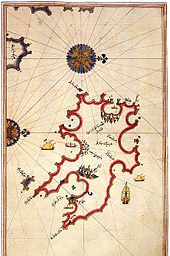 The Ottoman invasion of the Balearic Islands in 1558 and assaults on the port cities of the Spanish mainland led to the Battle of Djerba in 1560.
The Ottoman invasion of the Balearic Islands in 1558 and assaults on the port cities of the Spanish mainland led to the Battle of Djerba in 1560.
The effective military and bureaucratic structures of the previous century also came under strain during a protracted period of misrule by weak Sultans. But in spite of these difficulties, the Empire remained a major expansionist power until the Battle of Vienna in 1683, which marked the end of Ottoman expansion into Europe.
European states initiated efforts at this time to curb Ottoman control of the traditional overland trade routes between East Asia and Western Europe, which started with the Silk Road. Western European states began to avoid the Ottoman trade monopoly by establishing their own maritime routes to Asia through new discoveries at sea. The Portuguese discovery of the Cape of Good Hope in 1488 initiated a series of Ottoman-Portuguese naval wars in the Indian Ocean throughout the 16th century. Economically, the huge influx of Spanish silver from the New World caused a sharp devaluation of the Ottoman currency and rampant inflation. This had serious negative consequences at all levels of Ottoman society.
The expansion of Muscovite Russia under Ivan IV (1533–1584) into the Volga and Caspian region at the expense of the Tatar khanates disrupted the northern pilgrimage and trade routes. A highly ambitious plan to counter this conceived by Sokollu Mehmed Pasha, Grand Vizier under Selim II, in the shape of a Don-Volga canal (begun June 1569), combined with an attack on Astrakhan, failed, the canal being abandoned with the onset of winter. Henceforth the Empire returned to its existing strategy of utilizing the Crimean Khanate as its bulwark against Russia.[42] In 1571, the Crimean khan Devlet I Giray, supported by the Ottomans, burned Moscow.[43] The next year, the invasion was repeated but repelled at the Battle of Molodi. The Crimean Khanate continued to invade Eastern Europe in a series of slave raids,[44] and remained a significant power in Eastern Europe and a threat to Muscovite Russia in particular until the end of the 17th century.[45]
In southern Europe, a coalition of Catholic powers, led by Philip II of Spain, formed an alliance to challenge Ottoman naval strength in the Mediterranean Sea. Their victory over the Ottoman fleet at the Battle of Lepanto (1571) was a startling blow to the image of Ottoman invincibility. However, historians today stress the symbolic and not the strictly military significance of the battle, for within six months of the defeat a new Ottoman fleet of some 250 sail including eight modern galleasses[46] had been built, with the harbours of Constantinople turning out a new ship every day at the height of the construction. In discussions with a Venetian minister, the Ottoman Grand Vizier commented: "In capturing Cyprus from you, we have cut off one of your arms; in defeating our fleet you have merely shaved off our beard".[46] The Ottoman naval recovery persuaded Venice to sign a peace treaty in 1573, and the Ottomans were able to expand and consolidate their position in North Africa.[47] However, what could not be replaced were the experienced naval officers and sailors. The Battle of Lepanto was far more damaging to the Ottoman navy in sapping experienced manpower than the loss of ships, which were rapidly replaced.[48]
By contrast, the Habsburg frontier had settled into a reasonably permanent border, marked only by relatively minor battles concentrating on the possession of individual fortresses. The stalemate was caused by a stiffening of the Habsburg defences[49] and reflected simple geographical limits: in the pre-mechanized age, Vienna marked the furthest point that an Ottoman army could march from Constantinople during the early spring to late autumn campaigning season. It also reflected the difficulties imposed on the Empire by the need to support two separate fronts: one against the Austrians (see: Ottoman wars in Europe), and the other against a rival Islamic state, the Safavids of Persia (see: Ottoman wars in Near East).
 The Battle of Keresztes (1596) was part of the Long War (1593–1606) between the Ottoman and Habsburg empires, which ended with Ottoman victory, resulting in the Peace of Zsitvatorok in 1606.
The Battle of Keresztes (1596) was part of the Long War (1593–1606) between the Ottoman and Habsburg empires, which ended with Ottoman victory, resulting in the Peace of Zsitvatorok in 1606.
On the battlefield, the Ottomans gradually fell behind the Europeans in military technology as the innovation that fed the Empire's forceful expansion became stifled by growing religious and intellectual conservatism.[50] Changes in European military tactics and weaponry in the military revolution caused the once-feared Sipahi cavalry to lose military relevance. The Long War against Habsburg Austria (1593–1606) created the need for greater numbers of infantry equipped with firearms. This resulted in a relaxation of recruitment policy and a significant growth in Janissary corps numbers. This contributed to problems of indiscipline, lack of effectiveness, and outright rebelliousness within the corps, which the government wrestled with but never fully solved during (and beyond) this whole period.[51] The development of pike and shot and later linear tactics with increased use of firearms by Europeans proved deadly against the massed infantry in close formation used by the Ottomans. Irregular sharpshooters (Sekban) were also recruited for the same reasons and on demobilization turned to brigandage in the Jelali revolts (1595–1610), which engendered widespread anarchy in Anatolia in the late 16th and early 17th centuries.[52] With the Empire's population reaching 30,000,000 people by 1600, shortage of land placed further pressure on the government.[53]
However, the 17th century was not simply an era of stagnation and decline, but also a key period in which the Ottoman state and its structures began to adapt to new pressures and new realities, internal and external. The Sultanate of women (1648–1656) was a period in which the political influence of the Imperial Harem was dominant, as the mothers of young sultans exercised power on behalf of their sons. This was not wholly unprecedented; Hürrem Sultan, who established herself in the early 1530s as the successor of Nurbanu, the first Valide Sultan, was described by the Venetian Baylo Andrea Giritti as "a woman of the utmost goodness, courage and wisdom" even though she "thwarted some while rewarding others".[54] But the inadequacy of Ibrahim I (1640–1648) and the minority accession of Mehmed IV in 1646 created a significant crisis of rule, which the dominant women of the Imperial Harem filled. The most prominent women of this period were Kösem Sultan and her daughter-in-law Turhan Hatice, whose political rivalry culminated in Kösem's murder in 1651.[55]
This period gave way to the highly significant Köprülü Era (1656–1703), during which effective control of the Empire was exercised by a sequence of Grand Viziers from the Köprülü family. On September 15, 1656 the octogenarian Köprülü Mehmed Pasha accepted the seals of office having received guarantees from the Valide Turhan Hatice of unprecedented authority and freedom from interference. A fierce conservative disciplinarian, he successfully reasserted the central authority and the empire's military impetus. This continued under his son and successor Köprülü Fazıl Ahmed (Grand Vizier 1661–1676).[56] The Köprülü Vizierate saw renewed military success with authority restored in Transylvania, the conquest of Crete completed in 1669 and expansion into Polish southern Ukraine, with the strongholds of Khotyn and Kamianets-Podilskyi and the territory of Podolia ceding to Ottoman control in 1676.[57]
This period of renewed assertiveness came to a calamitous end when Grand Vizier Kara Mustafa Pasha in May 1683 led a huge army to attempt a second Ottoman siege of Vienna in the Great Turkish War of 1683-1687. The final assault being fatally delayed, the Ottoman forces were swept away by allied Habsburg, German and Polish forces spearheaded by the Polish king Jan[58] at the Battle of Vienna.
The alliance of the Holy League pressed home the advantage of the defeat at Vienna and, thus, fifteen (15) years of see-sawing warfare, culminated in the epochal Treaty of Karlowitz (26 January 1699), which ended the Great Turkish War.[59] For the first time, the Ottoman Empire surrender control of significant European territories (many permanently), including Ottoman Hungary.[60] The Empire had reached the end of its ability to effectively conduct an assertive, expansionist policy against its European rivals and it was to be forced from this point to adopt an essentially defensive strategy within this theatre.
Only two Sultans in this period personally exercised strong political and military control of the Empire: the vigorous Murad IV (1612–1640) recaptured Yerevan (1635) and Baghdad (1639) from the Safavids and reasserted central authority, albeit during a brief majority reign.[61] Mustafa II (1695–1703) led the Ottoman counter attack of 1695–6 against the Habsburgs in Hungary, but was undone at the disastrous defeat at Zenta (September 11, 1697).[62]
Stagnation and reform (1683–1827)
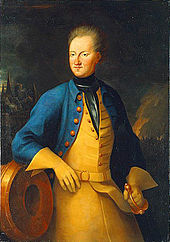 King Charles XII of Sweden fled to the Ottoman Empire following his defeat against the Russians at the Battle of Poltava in 1709. A guest of the Turks for nearly five years, he persuaded the Ottoman Sultan Ahmed III to declare war on Russia, which resulted in the Russo-Turkish War of 1710–1711 that ended with an Ottoman victory.
King Charles XII of Sweden fled to the Ottoman Empire following his defeat against the Russians at the Battle of Poltava in 1709. A guest of the Turks for nearly five years, he persuaded the Ottoman Sultan Ahmed III to declare war on Russia, which resulted in the Russo-Turkish War of 1710–1711 that ended with an Ottoman victory.
During this period threats to the Ottoman Empire were presented by the traditional foe—the Austrian Empire—as well as by a new foe—the rising Russian Empire. The Ottomans ceded much territory in the Balkans to Austria. Certain areas of the Empire, such as Egypt and Algeria, became independent in all but name, and later came under the influence of Britain and France. Later, in the 18th century, centralized authority within the Ottoman Empire, gave way to varying degrees of provincial autonomy enjoyed by local governors and leaders.
However, Russian expansion presented large and growing threat.[63] Accordingly, King Charles XII of Sweden was welcomed as an ally in the Ottoman Empire following his defeat by the Russians at the Battle of Poltava in 1709 (part of the Great Northern War of 1700–1721.)[63] Charles XII persuaded the Ottoman Sultan Ahmed III to declare war on Russia, which resulted in the Ottoman victory at the Pruth River Campaign of 1710–1711.[64] The subsequent Treaty of Passarowitz signed on July 21, 1718, brought a period of peace between wars. However, the Treaty also revealed that the Ottoman Empire was on the defensive and unlikely to present any further aggression in Europe.[65]
During the Tulip Era (1718–1730), named for Sultan Ahmed III's love of the tulip flower and its use to symbolize his peaceful reign, the Empire's policy towards Europe underwent a shift. The Empire began to improve the fortifications of its cities in the Balkan peninsula to act as a defence against European expansionism. Cultural works, fine arts and architecture flourished, with more elaborate styles that were influenced by the Baroque and Rococo movements in Europe. A classic example is the Fountain of Ahmed III in front of the Topkapı Palace. The famous Flemish-French painter Jean-Baptiste van Mour visited the Ottoman Empire during the Tulip Era and crafted some of the most renowned works of art depicting scenes from daily life in the Ottoman society and the imperial court.[66]
Upon the death of Peter the Great in 1725, Catherine, Peter's wife succeeded to the throne of the Russian Empire as Czarina Catherine I. Together with Austria, Russia, under Catherine I, engaged in a war against the Ottoman Empire from 1735 until 1739. The Treaty of Belgrade signed on September 18, 1739, ended this war and resulted in the loss of Serbia and "Little Walachia" to Austria and the port of Azov to the Russians. However following the Treaty of Belgrade, the Ottoman Empire was able to enjoy a generation of peace as Austria and Russia were forced to deal with the rise of the Prussians under King Frederick the Great.[67] This long period of Ottoman peace and, indeed, stagnation is typically characterized by historians as an era of failed reforms. In the latter part of this period there were educational and technological reforms, including the establishment of higher education institutions such as the Istanbul Technical University.[68] Ottoman science and technology had been highly regarded in medieval times, as a result of Ottoman scholars' synthesis of classical learning with Islamic philosophy and mathematics, and knowledge of such Chinese advances in technology as gunpowder and the magnetic compass. By this period, though, the influences had become regressive and conservative. In 1734, when an artillery school was established with French teachers in order to impart Western-style artillery methods, the Islamic clergy successfully objected under the grounds of theodicy.[69] Not until 1754 was the artillery school re-opened on a semi-secret basis.[69] Earlier, the guilds of writers had denounced the printing press as "the Devil's Invention", and were responsible for a 53-year lag between its invention by Johannes Gutenberg in Europe in c. 1440 and its introduction to the Ottoman society with the first Gutenberg press in Constantinople that was established by the Sephardic Jews of Spain in 1493 (who had migrated to the Ottoman Empire a year earlier, escaping from the Spanish Inquisition of 1492.) However, the printing press was used only by the non-Muslims in the Ottoman Empire until the 18th century. In 1726, Ibrahim Muteferrika convinced the Grand Vizier Nevşehirli Damat İbrahim Pasha, the Grand Mufti, and the clergy on the efficiency of the printing press, and later submitted a request to Sultan Ahmed III, who granted Muteferrika the permission to publish non-religious books (despite opposition from some calligraphers and religious leaders.)[70] Muteferrika's press published its first book in 1729, and, by 1743, issued 17 works in 23 volumes (each having between 500 and 1,000 copies.)[70][71]
Other tentative reforms were also enacted: taxes were lowered, there were attempts to improve the image of the Ottoman state, and the first instances of private investment and entrepreneurship occurred.
Following the period of peace, which had lasted since 1739, Russia began to assert its expansionistic desires again in 1768. Under the pretext of pursuing fugitive Polish revolutionaries, Russian troops entered Balta an Ottoman-controlled city on the border of Bessarabia and massacred its citizens and burned the town to the ground.[72] This action provoked the Ottoman Empire into the First Russo-Turkish War of 1768-1774. The Treaty of Kuchuk Kainraji of 1774 ended the First Russo-Turkish War and allowed that the Christian citizens of the Ottoman-controlled Rumanian provinces of Wallachia and Moldavia would be allowed freedom to worship.[73] Russia was made the guarantor of their right to Christian worship.
A series of wars were fought between the Russian and Ottoman empires from the 18th to the 19th century. By the late 18th century, a number of defeats in several wars with Russia led some people in the Ottoman Empire to conclude that the reforms of "Deli Petro" (Peter the Mad, as Peter the Great was known in Turkey) had given the Russians an edge, and the Ottomans would have to keep up with Western technology in order to avoid further defeats.[69]
Ottoman military reform efforts begin with Selim III (1789–1807) who made the first major attempts to modernize the army along European lines. These efforts, however, were hampered by reactionary movements, partly from the religious leadership, but primarily from the Janissary corps, who had become anarchic and ineffectual. Jealous of their privileges and firmly opposed to change, they created a Janissary revolt. Selim's efforts cost him his throne and his life, but were resolved in spectacular and bloody fashion by his successor, the dynamic Mahmud II, who massacred the Janissary corps in 1826.
The Serbian revolution (1804–1815) marked the beginning of an era of national awakening in the Balkans during the Eastern Question. Suzerainty of Serbia as a hereditary monarchy under its own dynasty was acknowledged de jure in 1830.[74][75] In 1821, the Greeks declared war on the Sultan. A rebellion that originated in Moldavia as a diversion was followed by the main revolution in the Peloponnese, which, along with the northern part of the Gulf of Corinth, became the first parts of the Ottoman empire to achieve independence (in 1829). By the mid-19th century, the Ottoman Empire was called the "sick man" by Europeans. The suzerain states – the Principality of Serbia, Wallachia, Moldavia and Montenegro -- moved towards de jure independence during the 1860s and 1870s.
Decline and modernization (1828–1908)
During this period, the Empire faced challenges in defending itself against foreign invasion and occupation. The Empire ceased to enter conflicts on its own and began to forge alliances with European countries such as France, the Netherlands, Britain, and Russia. As an example, in the 1853 Crimean War, the Ottomans united with Britain, France, and the Kingdom of Sardinia against Russia.
Modernization
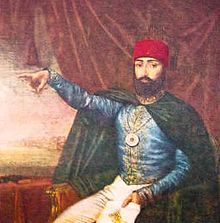 Mahmud II started the modernization of Turkey by paving the way for the Edict of Tanzimat in 1839 (implemented immediately after his death by his son Sultan Abdülmecid) which instituted European-style clothing, uniforms, weapons, architecture, education, legislation, banking, institutional organization, agricultural and industrial innovations, new technologies in transport and communications, and land reform.
Mahmud II started the modernization of Turkey by paving the way for the Edict of Tanzimat in 1839 (implemented immediately after his death by his son Sultan Abdülmecid) which instituted European-style clothing, uniforms, weapons, architecture, education, legislation, banking, institutional organization, agricultural and industrial innovations, new technologies in transport and communications, and land reform.
During the Tanzimat period (from Arabic تنظيم tanẓīm, meaning "organization") (1839–1876), the government's series of constitutional reforms led to a fairly modern conscripted army, banking system reforms, the decriminalisation of homosexuality, the replacement of religious law with secular law [76] and guilds with modern factories. In 1856, the Hatt-ı Hümayun promised equality for all Ottoman citizens regardless of their ethnicity and religious confession; which thus widened the scope of the 1839 Hatt-ı Şerif of Gülhane.
Overall, the Tanzimat reforms had far-reaching effects. Those educated in the schools established during the Tanzimat period included Mustafa Kemal Atatürk and other progressive leaders and thinkers of the Republic of Turkey and of many other former Ottoman states in the Balkans, the Middle East and North Africa. These reforms included[77] guarantees to ensure the Ottoman subjects perfect security for their lives, honour, and property; the introduction of the first Ottoman paper banknotes (1840) and opening of the first post offices (1840); the reorganization of the finance system according to the French model (1840); the reorganization of the Civil and Criminal Code according to the French model (1840); the establishment of the Meclis-i Maarif-i Umumiye (1841) which was the prototype of the First Ottoman Parliament (1876); the reorganization of the army and a regular method of recruiting, levying the army, and fixing the duration of military service (1843–44); the adoption of an Ottoman national anthem and Ottoman national flag (1844); the first nationwide Ottoman census in 1844 (only male citizens were counted); the first national identity cards (officially named the Mecidiye identity papers, or informally kafa kağıdı (head paper) documents, 1844); the institution of a Council of Public Instruction (1845) and the Ministry of Education (Mekatib-i Umumiye Nezareti, 1847, which later became the Maarif Nezareti, 1857); the abolition of slavery and slave trade (1847); the establishment of the first modern universities (darülfünun, 1848), academies (1848) and teacher schools (darülmuallimin, 1848); establishment of the Ministry of Healthcare (Tıbbiye Nezareti, 1850); the Commerce and Trade Code (1850); establishment of the Academy of Sciences (Encümen-i Daniş, 1851); establishment of the Şirket-i Hayriye which operated the first steam-powered commuter ferries (1851); the first European style courts (Meclis-i Ahkam-ı Adliye, 1853) and supreme judiciary council (Meclis-i Ali-yi Tanzimat, 1853); establishment of the modern Municipality of Istanbul (Şehremaneti, 1854) and the City Planning Council (İntizam-ı Şehir Komisyonu, 1855); the abolition of the capitation (Jizya) tax on non-Muslims, with a regular method of establishing and collecting taxes (1856); non-Muslims were allowed to become soldiers (1856); various provisions for the better administration of the public service and advancement of commerce; the establishment of the first telegraph networks (1847–1855) and railroads (1856); the replacement of guilds with factories; the establishment of the Ottoman Central Bank (originally established as the Bank-ı Osmanî in 1856, and later reorganized as the Bank-ı Osmanî-i Şahane in 1863)[78] and the Ottoman Stock Exchange (Dersaadet Tahvilat Borsası, established in 1866);[79] the Land Code (Arazi Kanunnamesi, 1857); permission for private sector publishers and printing firms with the Serbesti-i Kürşad Nizamnamesi (1857); establishment of the School of Economical and Political Sciences (Mekteb-i Mülkiye, 1859); the Press and Journalism Regulation Code (Matbuat Nizamnamesi, 1864); among others.[77]
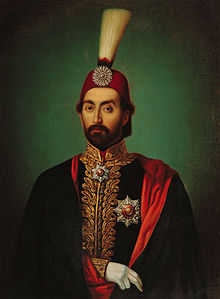 The reign of Sultan Abdülmecid was marked by the implementation of the Tanzimat reforms; the Crimean War and first foreign debt of the Ottoman Empire in 1854 (the payments of which were completed by the Republic of Turkey a century later, in 1954);[80] and the Treaty of Paris (1856) which secured Ottoman control over the Balkan peninsula and the Black Sea basin until the Russo-Turkish War of 1877–1878.
The reign of Sultan Abdülmecid was marked by the implementation of the Tanzimat reforms; the Crimean War and first foreign debt of the Ottoman Empire in 1854 (the payments of which were completed by the Republic of Turkey a century later, in 1954);[80] and the Treaty of Paris (1856) which secured Ottoman control over the Balkan peninsula and the Black Sea basin until the Russo-Turkish War of 1877–1878.
The Ottoman Ministry of Post was established in Istanbul on 23 October 1840.[81][82] The first post office was the Postahane-i Amire near the courtyard of the Yeni Mosque.[81] In 1876 the first international mailing network between Istanbul and the lands beyond the vast Ottoman Empire was established.[81] In 1901 the first money transfers were made through the post offices and the first cargo services became operational.[81]
Samuel Morse received his first ever patent for the telegraph in 1847, at the old Beylerbeyi Palace (the present Beylerbeyi Palace was built in 1861–1865 on the same location) in Constantinople, which was issued by Sultan Abdülmecid who personally tested the new invention.[83] Following this successful test, installation works of the first telegraph line (Istanbul-Edirne-Şumnu)[84] began on 9 August 1847.[85] In 1855 the Ottoman telegraph network became operational and the Telegraph Administration was established.[81][82][84] In 1871 the Ministry of Post and the Telegraph Administration were merged, becoming the Ministry of Post and Telegraph.[82] In July 1881 the first telephone circuit in Istanbul was established between the Ministry of Post and Telegraph in the Soğukçeşme quarter and the Postahane-i Amire in the Yenicami quarter.[85] On 23 May 1909, the first manual telephone exchange with a 50 line capacity entered service in the Büyük Postane (Grand Post Office) of Sirkeci.[85]
The first two railway lines in the Ottoman Empire entered service in 1856; these were the Cairo-Alexandria line (1856) and the İzmir-Aydın line (1856), the latter being operated by the Oriental Railway Company. They were followed by the Köstence-Boğazköy railway line (1860); the Smyrne Cassaba & Prolongements (1863) which operated between İzmir, Afyon and Bandırma; the Rusçuk–Varna railway line (1866); the Bükreş-Yergöğü railway line (1869); the Chemins de fer Orientaux (1869) which operated between Vienna, Banja Luka, Saraybosna, Niš, Sofia, Filibe, Edirne and Istanbul (starting from 1889 between Paris and Istanbul as the Orient Express); the Chemin de Fer Moudania Brousse (1871) which operated between Mudanya and Bursa; the Istanbul-Belovo railway line (1873); the Üsküp-Selânik railway line (1873); the Mersin-Tarsus-Adana Railway (1882); the Chemins de Fer Ottomans d'Anatolie (1888) which operated between Istanbul, Izmit, Adapazarı, Bilecik, Eskişehir, Ankara, Kütahya and Konya; the Jaffa–Jerusalem railway (1892); the Beirut-Damascus railway (1895); the Baghdad Railway (1904) which operated between Istanbul, Konya, Adana, Aleppo and Baghdad; the Jezreel Valley railway (1905) which operated between Acre, Haifa, Bosra, Hauran, Yagur, Daraa, Samakh, Beit She'an and Silat ad-Dhahr; the Hejaz Railway (1908) which operated between Istanbul, Konya, Adana, Aleppo, Damascus, Amman, Tabuk and Medina; the Eastern Railway (1915) which operated between Tulkarm and Lod; and the Beersheba Railway (1915) which connected Nahal Sorek with Beit Hanoun and Beersheba.
The reformist period peaked with the Constitution, called the Kanûn-ı Esâsî (meaning "Basic Law" in Ottoman Turkish), written by members of the Young Ottomans, which was promulgated on November 23, 1876. It established the freedom of belief and equality of all citizens before the law. The Empire's First Constitutional era, was short-lived. But the idea of Ottomanism proved influential. A group of reformers known as the Young Ottomans, primarily educated in western universities, believed that a constitutional monarchy would give an answer to the Empire's growing social unrest. Through a military coup in 1876, they forced Sultan Abdülaziz (1861–1876) to abdicate in favour of Murad V. However, Murad V was mentally ill and was deposed within a few months. His heir-apparent, Abdülhamid II (1876–1909), was invited to assume power on the condition that he would declare a constitutional monarchy, which he did on November 23, 1876. The parliament survived for only two years before the sultan suspended it. When forced to reconvene it, he abolished the representative body instead. This ended the effectiveness of the Kanûn-ı Esâsî.
The Christian millets gained privileges, such as in the Armenian National Constitution of 1863. This Divan-approved form of the Code of Regulations consisted of 150 articles drafted by the Armenian intelligentsia. Another institution was the newly formed Armenian National Assembly.[86] The Christian population of the empire, owing to their higher educational levels, started to pull ahead of the Muslim majority, leading to much resentment on the part of the latter.[87] In 1861, there were 571 primary and 94 secondary schools for Ottoman Christians with 140,000 students in total, a figure that vastly exceeded the number of Muslim children in school at the same time, who were further hindered by the amount of time spent learning Arabic and Islamic theology.[87] In turn, the higher educational levels of the Christians allowed them to play a large role in the economy.[87] In 1911, of the 654 wholesale companies in Constantinople, 528 were owned by ethnic Greeks.[87]
Crimean War
The Crimean War (1853–1856) was part of a long-running contest between the major European powers for influence over territories of the declining Ottoman Empire. Most of the conflict took place on the Crimean Peninsula, but there were smaller campaigns in western Anatolia, the Caucasus, the Baltic Sea, the Pacific Ocean and the White Sea. It is often considered to be one of the first "modern" wars, as it introduced technical changes which affected the future course of warfare, including the first tactical use of railways and the telegraph.[88] It is also famous for the work of Florence Nightingale and Mary Seacole, who pioneered modern nursing practices while caring for wounded British soldiers.[89] The Crimean War was one of the first wars to be documented extensively in written reports and photographs: notably by William Russell (for The Times newspaper) and Roger Fenton, respectively. News correspondence reaching Britain from the Crimea was the first time the public were kept informed of the day-to-day realities of war.
The Ottoman Empire took its first foreign loans on 4 August 1854,[80] shortly after the beginning of the Crimean War.[90]
The war caused an exodus of the Crimean Tatars. From the total Tatar population of 300,000 in the Tauride Province, about 200,000 Crimean Tatars moved to the Ottoman Empire in continuing waves of emigration.[91] Toward the end of the Caucasian Wars, many Circassians fled their homelands in the Caucasus and settled in the Ottoman Empire. Since the 19th century, the exodus to present-day Turkey by the large portion of Muslim peoples from the Balkans, Caucasus, Crimea and Crete,[92] had great influence in molding the country's fundamental features. These people were called Muhacir under a general definition.[93] By the time the Ottoman Empire came to an end in 1922, half of the urban population of Turkey was descended from Muslim refugees from Russia.[87] Crimean Tartar refugees in the late 19th century played an especially notable role in seeking to modernize Turkish education.[87]
The subsequent Treaty of Paris (1856) secured Ottoman control over the Balkan peninsula and the Black Sea basin until the Russo-Turkish War of 1877–1878.
Ethnic nationalism
The rise of nationalism swept through many countries during the 19th century, and it affected territories within the Ottoman Empire. A burgeoning national consciousness, together with a growing sense of ethnic nationalism, made nationalistic thought one of the most significant Western ideas imported to the Ottoman empire. It was forced to deal with nationalism both within and beyond its borders. The number of revolutionary political parties rose dramatically. Uprisings in Ottoman territory had many far-reaching consequences during the 19th century and determined much of Ottoman policy during the early 20th century. Many Ottoman Turks questioned whether the policies of the state were to blame: some felt that the sources of ethnic conflict were external, and unrelated to issues of governance. While this era was not without some successes, the ability of the Ottoman state to have any effect on ethnic uprisings was seriously called into question.
In 1804 the Serbian revolution against Ottoman rule erupted in the Balkans, running in parallel with the Napoleonic invasion. By 1817, when the revolution ended, Serbia was raised to the status of self-governing monarchy under nominal Ottoman suzerainty.[94][95] In 1821 the First Hellenic Republic became the first Balkan country to achieve its independence from the Ottoman Empire. It was officially recognized by the Porte in 1829, after the end of the Greek War of Independence.
Balkans
The Tanzimat reforms did not halt the rise of nationalism in the Danubian Principalities and the Principality of Serbia, which had been semi-independent for almost six decades. In 1875 the tributary principalities of Serbia and Montenegro, and the United Principalities of Wallachia and Moldavia, unilaterally declared their independence from the Empire. Following the Russo-Turkish War of 1877–1878, the empire granted independence to all three belligerent nations. Bulgaria also achieved virtual independence[citation needed] (as the Principality of Bulgaria); its volunteers had participated in the Russo-Turkish war on the side of the rebelling nations.
Congress of Berlin
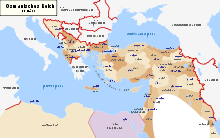 Map of the Ottoman Empire in 1900,[96] with the names of the Ottoman provinces between 1878 and 1908.
Map of the Ottoman Empire in 1900,[96] with the names of the Ottoman provinces between 1878 and 1908.
The Congress of Berlin (13 June – 13 July 1878) was a meeting of the leading statesmen of Europe's Great Powers and the Ottoman Empire. In the wake of the Russo-Turkish War (1877–1878) that ended with a decisive victory for Russia and her Orthodox Christian allies (subjects of the Ottoman Empire before the war) in the Balkan peninsula, the urgent need was to stabilize and reorganize the Balkans, and set up new nations. German Chancellor Otto von Bismarck, who led the Congress, undertook to adjust boundaries to minimize the risks of major war, while recognizing the reduced power of the Ottomans, and balance the distinct interests of the great powers.
As a result, Ottoman holdings in Europe declined sharply; Bulgaria was established as an independent principality inside the Ottoman Empire, but was not allowed to keep all its previous territory. Bulgaria lost Eastern Rumelia, which was restored to the Turks under a special administration; and Macedonia, which was returned outright to the Turks, who promised reform. Romania achieved full independence, but had to turn over part of Bessarabia to Russia. Serbia and Montenegro finally gained complete independence, but with smaller territories.
In 1878, Austria-Hungary unilaterally occupied the Ottoman provinces of Bosnia-Herzegovina and Novi Pazar, but the Ottoman government contested this move and maintained its troops in both provinces. The stalemate lasted for 30 years (Austrian and Ottoman forces coexisted in Bosnia and Novi Pazar for three decades) until 1908, when the Austrians took advantage of the political turmoil in the Ottoman Empire that stemmed from the Young Turk Revolution and annexed Bosnia-Herzegovina, but pulled their troops out of Novi Pazar in order to reach a compromise and avoid a war with the Turks. The Ottoman Empire lost Novi Pazar with the First Balkan War in 1912.
In return for British Prime Minister Benjamin Disraeli's advocacy for restoring the Ottoman territories on the Balkan peninsula during the Congress of Berlin, Britain assumed the administration of Cyprus in 1878[97] and later sent troops to Egypt in 1882 with the pretext of helping the Ottoman government to put down the Urabi Revolt; effectively gaining control in both territories (Britain formally annexed the still nominally Ottoman territories of Cyprus and Egypt on 5 November 1914, in response to the Ottoman Empire's decision to enter World War I on the side of the Central Powers.) France, on its part, occupied Tunisia in 1881.
The results were first hailed as a great achievement in peacemaking and stabilization. However, most of the participants were not fully satisfied, and grievances regarding the results festered until they exploded in world war in 1914. Serbia, Bulgaria, and Greece made gains, but far less than they thought they deserved. The Ottoman Empire, called at the time the "sick man of Europe," was humiliated and significantly weakened, rendering it more liable to domestic unrest and more vulnerable to attack. Although Russia had been victorious in the war that occasioned the conference, it was humiliated at Berlin, and resented its treatment. Austria gained a great deal of territory, which angered the South Slavs, and led to decades of tensions in Bosnia and Herzogovina. Bismarck became the target of hatred of Russian nationalists and Pan-Slavists, and found that he had tied Germany too closely to Austria in the Balkans.[98]
In the long-run, tensions between Russia and Austria-Hungary intensified, as did the nationality question in the Balkans. The Congress succeeded in keeping Constantinople in Ottoman hands. It effectively disavowed Russia's victory. The Congress of Berlin returned to the Ottoman Empire territories that the previous treaty had given to the Principality of Bulgaria, most notably Macedonia, thus setting up a strong revanchist demand in Bulgaria that in 1912 led to the First Balkan War in which the Ottomans were defeated and lost nearly all of Europe.
Egypt
In 1882 British forces occupied Egypt on the pretext of bringing order. Egypt and Sudan remained as Ottoman provinces de jure until 1914, when the Ottoman Empire joined the Central Powers of World War I. Great Britain officially annexed these two provinces and Cyprus in response. Other Ottoman provinces in North Africa were lost between 1830 and 1912, starting with Algeria (occupied by France in 1830), Tunisia (occupied by France in 1881) and Libya (occupied by Italy in 1912).
Armenia
Although granted their own constitution and national assembly with the Tanzimat reforms, the Armenians attempted to demand implementation of Article 61 from the Ottoman government as agreed upon at the Congress of Berlin in 1878.[99] Following pressure from the European powers and Armenians, Sultan Abdul Hamid II, in response, assigned the Hamidiye regiments to eastern Anatolia (Ottoman Armenia).[100] These were formed mostly of irregular cavalry units of recruited Kurds.[101] From 1894–96, between 100,000 to 300,000 Armenians living throughout the empire were killed in what became known as the Hamidian massacres.[102] Armenian militants seized the Ottoman Bank headquarters in Constantinople in 1896 to bring European attention to the massacres, but they failed to gain any help.
Economy
Economically, the Empire had difficulty in repaying the Ottoman public debt to European banks, which caused the establishment of the Council of Administration of the Ottoman Public Debt. By the end of the 19th century, the main reason the Empire was not overrun by Western powers was their attempt to maintain a balance of power in the area. Both Austria and Russia wanted to increase their spheres of influence and territory at the expense of the Ottoman Empire, but were kept in check mostly by Britain, which feared Russian dominance in the Eastern Mediterranean.
Dissolution (1908–1922)
The Second Constitutional Era began after the Young Turk Revolution (3 July 1908) with the sultan's announcement of the restoration of the 1876 constitution and the reconvening of the Ottoman Parliament. It marks the dissolution of the Ottoman Empire. This era is dominated by the politics of the Committee of Union and Progress, and the movement that would become known as the Young Turks.
Profiting from the civil strife, Austria-Hungary officially annexed Bosnia and Herzegovina in 1908, but pulled its troops out of the Sanjak of Novi Pazar, another contested region between the Austrians and Ottomans, to avoid a war. During the Italo-Turkish War (1911–12) in which the Ottoman Empire lost Libya, the Balkan League declared war against the Ottoman Empire, which lost its Balkan territories except East Thrace and the historic Ottoman capital city of Edirne (Adrianople) during the Balkan Wars (1912–13). Some 400,000 Muslims, out of fear for Greek, Serbian or Bulgarian atrocities, left with the retreating Ottoman army.[103] The Baghdad Railway under German control became a source of international tension and played a role in the origins of World War I.[104]
World War I (1914–1918)
The Young Turk government had signed a secret treaty with Germany and established the Ottoman-German Alliance in August 1914, aimed against the common Russian enemy but aligning the Empire with the German side. The Ottoman Empire entered World War I after the Goeben and Breslau incident, in which it gave safe harbour to two German ships that were fleeing British ships. These ships then—after having officially been transferred to the Ottoman Navy, but effectively still under German control—attacked the Russian port of Sevastopol, thus dragging the Empire into the war on the side of the Central Powers, in which it took part in the Middle Eastern theatre. There were several important Ottoman victories in the early years of the war, such as the Battle of Gallipoli and the Siege of Kut, but there were setbacks as well, such as the disastrous Caucasus Campaign against the Russians. The United States never declared war against the Ottoman Empire.[105]
In 1915, as the Russian Caucasus Army continued to advance in eastern Anatolia with the help of Armenian volunteer units from the Caucasus region of the Russian Empire,[106] and aided by some Ottoman Armenians, the Ottoman government decided to issue the Tehcir Law, which started the deportation of the ethnic Armenians, particularly from the provinces close to the Ottoman-Russian front, resulting in what became known as the Armenian Genocide.[107][108][109] Through forced marches and massacres, the Armenians living in eastern Anatolia were uprooted from their ancestral homelands and sent southwards to the Ottoman provinces in Syria and Mesopotamia. Estimates vary on how many Armenians perished during the Armenian Genocide but scholars give figures ranging from 300,000 (per the modern Turkish state), 600,000 (per early estimates by Western researchers)[110] to up to 1.0 million to up to 1.5 million (per modern Western and Armenian scholars).[111][112][113][114][115][116]
The Arab Revolt which began in 1916 turned the tide against the Ottomans at the Middle Eastern front, where they initially seemed to have the upper hand during the first two years of the war. When the Armistice of Mudros was signed on October 30, 1918, the only parts of the Arabian peninsula that were still under Ottoman control were Yemen, Asir, the city of Medina, portions of northern Syria and portions of northern Iraq. These territories were handed over to the British forces on 23 January 1919. The Ottomans were also ordered to evacuate the parts of the former Russian Empire in the Caucasus (in present-day Georgia, Armenia and Azerbaijan), which they had gained towards the end of World War I, following Russia's retreat from the war with the Russian Revolution in 1917.
Under the terms of the Treaty of Sèvres, the partitioning of the Ottoman Empire was solidified. The new countries created from the former territories of the Ottoman Empire currently number 39.
Turkish War of Independence (1919–1922)
The occupation of Constantinople along with the occupation of İzmir mobilized the establishment of the Turkish national movement, which won the Turkish War of Independence (1919–22) under the leadership of Mustafa Kemal Pasha.[117] The Sultanate was abolished on 1 November 1922, and the last sultan, Mehmed VI Vahdettin (reigned 1918–22), left the country on 17 November 1922. The new independent Grand National Assembly of Turkey (GNA) was internationally recognized with the Treaty of Lausanne on 24 July 1923. The GNA officially declared the Republic of Turkey on 29 October 1923. The Caliphate was constitutionally abolished several months later, on 3 March 1924. The Sultan and his family were declared personae non gratae of Turkey and exiled.
Ottoman descendants during and after the exile
In 1974, descendants of the dynasty were granted the right to acquire Turkish citizenship by the Grand National Assembly, and were notified that they could apply. Mehmed Orhan, son of Prince Mehmed Abdul Kadir of the Ottoman Empire, died in 1994, leaving the grandson of Ottoman Sultan Abdülhamid II, Ertuğrul Osman, as the eldest surviving member of the deposed dynasty. Osman for many years refused to carry a Turkish passport, calling himself a citizen of the Ottoman Empire. Despite this attitude, he put the matter of an Ottoman restoration to rest when he told an interviewer "no" to the question of whether he wished the Ottoman Empire to be restored. He was quoted as saying that "democracy works well in Turkey."[118] He returned to Turkey in 1992 for the first time since the exile, and became a Turkish citizen with a Turkish passport in 2002.[119]
On 23 September 2009, Osman died at the age of 97 in Istanbul, and with his death the last of the line born under the Ottoman Empire was extinguished. In Turkey, Osman was known as "the last Ottoman".[120]
Bayezid Osman, the second son of Sultan Abdülmecid I's younger grandson, Ibrahim Tevfik, is now the current eldest surviving member of the former ruling dynasty.
Fall of the Empire
The Empire's communication technology was not sufficiently developed to reach all territories.[citation needed]In many ways, the circumstances surrounding the Ottoman Empire's fall closely paralleled those surrounding the decline of the Roman Empire, particularly in the ongoing tensions between the Empire's different ethnic groups, and the various governments' inability to deal with these tensions. In the case of the Ottomans, the introduction of increased cultural rights, civil liberties and a parliamentary system during the Tanzimat proved too late to reverse the nationalistic and secessionist trends that had already been set in motion since the early 19th century.[citation needed]
Economy
Economic History
of the Ottoman Empire
Taxation in the Ottoman Empire 
Taxes Adet-i Ağnam · Adet-i deştbani · Ashar · Avarız · Bac-i pazar · Bedl-i askeri · Cizye · Cürm-ü cinayet · Damga resmi · Gümrük resmi · Haraç · Ihtisab · İspençe · Istira · Maktu · Mururiye resmi · Muskirat resmi · Nüzül · Otlak resmi · Rav akçesi · Resm-i arusane · Resm-i bennâk · Resm-i bostan · Resm-i çift · Resm-i dönüm · Resm-i ganem · Resm-i hınzır · Resm-i mücerred · Resm-i sicill · Rusum-e-eflak · Selamet isni · Tapu resmi · Tekalif-i orfiye · Temettu · Tuz resmi · Zakāt Implementation Ahidnâme · Defter · Düyun-ı Umumiye · Emin · Hazine-i Hassa · Hane · Iltizam · Istira · Kadı · Kanun-i Raya · Kanunname · Malikane · Millet · Muafiyet · Muhassil · Muqata'ah · Ottoman Public Debt Administration · Regie Company · Sursat · Tahrir · Waqf  Bankalar Caddesi (Banks Street) in Galata was the financial center of the Ottoman Empire. The Ottoman Central Bank is the first building at right.
Bankalar Caddesi (Banks Street) in Galata was the financial center of the Ottoman Empire. The Ottoman Central Bank is the first building at right.
Ottoman government deliberately pursued a policy for the development of Bursa, Edirne (Adrianople) and Constantinople, successive Ottoman capitals, into major commercial and industrial centres, considering that merchants and artisans were indispensable in creating a new metropolis.[121] To this end, Mehmed and his successor Bayezid, also encouraged and welcomed migration of the Jews from different parts of Europe, who were settled in Constantinople and other port cities like Salonica. In many places in Europe, Jews were suffering persecution at the hands of their Christian counterparts. The tolerance displayed by the Ottomans was welcomed by the immigrants. The Ottoman economic mind was closely related to the basic concepts of state and society in the Middle East in which the ultimate goal of a state was consolidation and extension of the ruler's power, and the way to reach it was to get rich resources of revenues by making the productive classes prosperous.[122] The ultimate aim was to increase the state revenues without damaging the prosperity of subjects to prevent the emergence of social disorder and to keep the traditional organization of the society intact.
The organization of the treasury and chancery were developed under the Ottoman Empire more than any other Islamic government and, until the 17th century, they were the leading organization among all their contemporaries.[123] This organization developed a scribal bureaucracy (known as "men of the pen") as a distinct group, partly highly trained ulema, which developed into a professional body.[123] The effectiveness of this professional financial body stands behind the success of many great Ottoman statesmen.[124] The economic structure of the Empire was defined by its geopolitical structure. The Ottoman Empire stood between the West and the East, thus blocking the land route eastward and forcing Spanish and Portuguese navigators to set sail in search of a new route to the Orient. The Empire controlled the spice route that Marco Polo once used. When Vasco da Gama bypassed Ottoman controlled routes and established direct trade links with India in 1498, and Christopher Columbus first journeyed to the Bahamas in 1492, the Ottoman Empire was at its zenith, an economic power that extended over three continents. Modern Ottoman studies think that the change in relations between the Ottomans and central Europe was caused by the opening of the new sea routes. It is possible to see the decline in the significance of the land routes to the East as Western Europe opened the ocean routes that bypassed the Middle East and Mediterranean as parallel to the decline of the Ottoman Empire itself. The Anglo-Ottoman Treaty, also known as the Treaty of Balta Liman that opened the Ottoman markets directly to English and French competitors, would be seen as one of the staging posts along this development.
By developing commercial centres and routes, encouraging people to extend the area of cultivated land in the country and international trade through its dominions, the state performed basic economic functions in the Empire. But in all this the financial and political interests of the state were dominant. Within the social and political system they were living in Ottoman administrators could not have comprehended or seen the desirability of the dynamics and principles of the capitalist and mercantile economies developing in Western Europe.[125]
State
State organisation of
the Ottoman Empire
The state organisation of the Ottoman Empire was a very simple system that had two main dimensions: the military administration and the civil administration. The Sultan was the highest position in the system. The civil system was based on local administrative units based on the region's characteristics. The Ottomans practiced a system in which the state (as in the Byzantine Empire) had control over the clergy. Certain pre-Islamic Turkish traditions that had survived the adoption of administrative and legal practices from Islamic Iran remained important in Ottoman administrative circles.[126] According to Ottoman understanding, the state's primary responsibility was to defend and extend the land of the Muslims and to ensure security and harmony within its borders within the overarching context of orthodox Islamic practice and dynastic sovereignty.[127]
The "Ottoman dynasty" or, as an institution, "House of Osman" was unprecedented and unequaled in the Islamic world for its size and duration.[128] The Ottoman dynasty was ethnically Turkish in its origins, as were some of its supporters and subjects, however the dynasty immediately lost this "Turkic" identification through intermarriage with different ethnicities.[129] On eleven occasions, the sultan was deposed because he was perceived by his enemies as a threat to the state. There were only two attempts in Ottoman history to unseat the ruling Osmanlı dynasty, both failures, which suggests a political system that for an extended period was able to manage its revolutions without unnecessary instability.[127]
The highest position in Islam, caliphate, was claimed by the sultan, which was established as Ottoman Caliphate. The Ottoman sultan, pâdişâh or "lord of kings", served as the Empire's sole regent and was considered to be the embodiment of its government, though he did not always exercise complete control. The Imperial Harem was one of the most important powers of the Ottoman court. It was ruled by the Valide Sultan. On occasion, the Valide Sultan would become involved in state politics. For a time, the women of the Harem effectively controlled the state in what was termed the "Sultanate of Women". New sultans were always chosen from the sons of the previous sultan. The strong educational system of the palace school was geared towards eliminating the unfit potential heirs, and establishing support among the ruling elite for a successor. The palace schools, which would also educate the future administrators of the state, were not a single track. First, the Madrasa (Ottoman Turkish: Medrese) was designated for the Muslims, and educated scholars and state officials according to Islamic tradition. The financial burden of the Medrese was supported by vakifs, allowing children of poor families to move to higher social levels and income.[130] The second track was a free boarding school for the Christians, the Enderûn,[131] which recruited 3,000 students annually from Christian boys between eight and twenty years old from one in forty families among the communities settled in Rumelia and/or the Balkans, a process known as Devshirme (Devşirme).[132]
Though the sultan was the supreme monarch, the sultan's political and executive authority was delegated. The politics of the state had a number of advisors and ministers gathered around a council known as Divan (after the 17th century it was renamed the "Porte"). The Divan, in the years when the Ottoman state was still a Beylik, was composed of the elders of the tribe. Its composition was later modified to include military officers and local elites (such as religious and political advisors). Later still, beginning in 1320, a Grand Vizier was appointed to assume certain of the sultan's responsibilities. The Grand Vizier had considerable independence from the sultan with almost unlimited powers of appointment, dismissal and supervision. Beginning with the late 16th century, sultans withdrew from politics and the Grand Vizier became the de facto head of state.[123]
Throughout Ottoman history, there were many instances in which local governors acted independently, and even in opposition to the ruler. After the Young Turk Revolution of 1908, the Ottoman state became a constitutional monarchy. The sultan no longer had executive powers. A parliament was formed, with representatives chosen from the provinces. The representatives formed the Imperial Government of the Ottoman Empire.
The rapidly expanding empire used loyal, skilled subjects to manage the Empire, whether Albanians, Phanariot Greeks, Armenians, Serbs, Hungarians or others. The incorporation of Greeks (and other Christians), Muslims, and Jews revolutionized its administrative system.[133]
This eclectic administration was apparent even in the diplomatic correspondence of the Empire, which was initially undertaken in the Greek language to the west.[129]
The Tughra were calligraphic monograms, or signatures, of the Ottoman Sultans, of which there were 35. Carved on the Sultan's seal, they bore the names of the Sultan and his father. The statement and prayer, “ever victorious,” was also present in most. The earliest belonged to Orhan Gazi. The ornately stylized Tughra spawned a branch of Ottoman-Turkish calligraphy.
Society
Social structure of the
Ottoman Empire
One of the successes of the social structure of the Ottoman Empire was the unity that it caused among its highly varied populations through an organization called millets. The millets were the major religious groups that were allowed to establish their own communities under Ottoman rule. The Millets were established by retaining their own religious laws, traditions, and language under the general protection of the sultan. Plurality was the key to the longevity of the Empire. As early as the reign of Mehmed II, extensive rights were granted to Phanariot Greeks, and Jews were invited to settle in Ottoman territory. Ultimately, the Ottoman Empire's relatively high degree of tolerance for ethnic differences were one of its greatest strengths in integrating the new regions but this non-assimilative policy became a weakness after the rise of nationalism. The dissolution of the Empire based on ethnic differentiation (balkanization) brought the end, which the failed Ottomanism among the citizens and participatory politics of the first or the constitutional Era had successfully addressed.
The lifestyle of the Ottoman Empire was a mixture of western and eastern life. One unique characteristic of Ottoman life style was it was very fragmented. The millet concept generated this fragmentation and enabled many to coexist in a mosaic of cultures. The capital of the Ottoman Empire, Constantinople also had a unique culture, mainly because before Ottoman rule it had been the seat of both the Roman and Byzantine Empires. The lifestyle in the Ottoman court in many aspects assembled ancient traditions of the Persian Shahs, but had many Greek and European influences. The culture that evolved around the Ottoman court was known as the Ottoman Way, which was epitomized with the Topkapı Palace. There were also large metropolitan centers where the Ottoman influence expressed itself with a diversity similar to metropolises of today: Sarajevo, Skopje, Thessaloniki, Dimashq, Baghdad, Beirut, Jerusalem, Makkah and Algiers with their own small versions of Ottoman Provincial Administration replicating the culture of the Ottoman court locally. The seraglio, which were the non-imperial places, in the context of the Turkish fashion, became the subject of works of art, where non-imperial prince or referring to other grand houses built around courtyards.
Slavery in the Ottoman Empire was a part of Ottoman society.[134] As late as 1908 women slaves were still sold in the Empire.[135] During the 19th century the Empire came under pressure from Western European countries to outlaw the practice. Policies developed by various Sultans throughout the 19th century attempted to curtail the slave trade but, since slavery did have centuries of religious backing and sanction, they could never directly abolish the institution outright—as had gradually happened in Western Europe and the Americas.
Plague remained a major event in Ottoman society until the second quarter of the 19th century. Between 1701 and 1750, 37 larger and smaller plague epidemics were recorded in Constantinople, and 31 between 1751 and 1800.[136]
See also: DevshirmehCulture
Culture of the
Ottoman Empire
Visual Arts Architecture · Miniature · Pottery · Calligraphy Performing Arts Shadowplay · Meddah · Dance · Music Languages and literature Ottoman Turkish · Poetry · Prose Sports Oil wrestling · Archery · Cirit Other Cuisine · Carpets · Clothing The Ottoman Empire had filled roughly the territories around the Mediterranean Sea and Black Sea while adopting the traditions, art and institutions of cultures in these regions and adding new dimensions to them. Many different cultures lived under the umbrella of the Ottoman Empire, and as a result, a specifically "Ottoman" culture can be difficult to define, except for those of the regional centers and capital. However, there was also a specific melding of cultures that can be said to have reached its highest levels among the Ottoman elite, who were composed of myriad ethnic and religious groups. This multicultural perspective of "millets" was reflected in the Ottoman State's multi-cultural and multi-religious policies. As the Ottomans moved further west, the Ottoman leaders absorbed some of the culture of the conquered regions. Intercultural marriages also played their part in creating the characteristic Ottoman elite culture. When compared to the Turkish folk culture, the influence of these new cultures in creating the culture of the Ottoman elite was clear.
Selimiye Mosque was the masterpiece of Mimar Sinan, chief architect of Sultans Selim I, Suleiman the Magnificent, Selim II and Murad III.
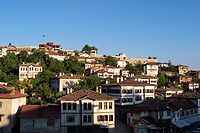 Safranbolu was inscribed as a UNESCO World Heritage Site in 1994 due to its well-preserved Ottoman residential architecture.
Safranbolu was inscribed as a UNESCO World Heritage Site in 1994 due to its well-preserved Ottoman residential architecture.
"Ottoman architecture" was influenced by Persian, Byzantine Greek and Islamic architectures. The Ottoman architecture are a continuation of the pre-Islamic Sassanid architecture. For instance, the dome covered square, which had been a dominant form in Sassanid became the nucleus of all Ottoman architecture.[137][138] During the Rise period the early or first Ottoman architecture period, Ottoman art was in search of new ideas. The growth period of the Empire become the classical period of architecture, when Ottoman art was at its most confident. During the years of the Stagnation period, Ottoman architecture moved away from this style, however.
During the Tulip Era, it was under the influence of the highly ornamented styles of Western Europe; Baroque, Rococo, Empire and other styles intermingled. Concepts of Ottoman architecture mainly circle the mosque. The mosque was integral to society, city planning and communal life. Besides the mosque, it is also possible to find good examples of Ottoman architecture in soup kitchens, theological schools, hospitals, Turkish baths and tombs. Examples of Ottoman architecture of the classical period, besides Istanbul and Edirne, can also be seen in Egypt, Eritrea, Tunisia, Algiers, the Balkans and Hungary, where mosques, bridges, fountains and schools were built. The art of Ottoman decoration developed with a multitude of influences due to the wide ethnic range of the Ottoman Empire. The greatest of the court artists enriched the Ottoman Empire with many pluralistic artistic influences: such as mixing traditional Byzantine art with elements of Chinese art.[139]
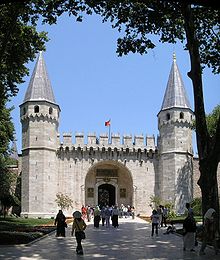 Topkapı Palace was the official and primary residence of the Ottoman Sultans from 1465 to 1856, the year when Sultan Abdülmecid I moved to the Dolmabahçe Palace.
Topkapı Palace was the official and primary residence of the Ottoman Sultans from 1465 to 1856, the year when Sultan Abdülmecid I moved to the Dolmabahçe Palace.
"Ottoman classical music" was an important part of the education of the Ottoman elite, a number of the Ottoman sultans were accomplished musicians and composers themselves, such as Selim III, whose compositions are often still performed today. Ottoman classical music arose largely from a confluence of Byzantine music, Arabic music, and Persian music. Compositionally, it is organised around rhythmic units called usul, which are somewhat similar to meter in Western music, and melodic units called makam, which bear some resemblance to Western musical modes.
The instruments used are a mixture of Anatolian and Central Asian instruments (the saz, the bağlama, the kemence), other Middle Eastern instruments (the ud, the tanbur, the kanun, the ney), and—later in the tradition—Western instruments (the violin and the piano). Because of a geographic and cultural divide between the capital and other areas, two broadly distinct styles of music arose in the Ottoman Empire: Ottoman classical music, and folk music. In the provinces, several different kinds of folk music were created. The most dominant regions with their distinguished musical styles are: Balkan-Thracian Türküs, North-Eastern (Laz) Türküs, Aegean Türküs, Central Anatolian Türküs, Eastern Anatolian Türküs, and Caucasian Türküs. Some of the distinctive styles were: Janissary Music, Roma music, Belly dance, Turkish folk music.
"Ottoman cuisine" refers to the cuisine of the capital—Constantinople, and the regional capital cities, where the melting pot of cultures created a common cuisine that all the populations enjoyed. This diverse cuisine was honed in the Imperial Palace's kitchens by chefs brought from certain parts of the Empire to create and experiment with different ingredients. The creations of the Ottoman Palace's kitchens filtered to the population, for instance through Ramadan events, and through the cooking at the Yalıs of the Pashas, and from there on spread to the rest of the population. Today, Ottoman cuisine lives in the Balkans, Anatolia and the Middle East, "common heirs to what was once the Ottoman life-style, and their cuisines offer treacherous circumstantial evidence of this fact".[140] It is typical of any great cuisine in the world to be based on local varieties and on mutual exchange and enrichment among them, but at the same time to be homogenized and harmonized by a metropolitan tradition of refined taste.[140]
Numerous traditions and cultural traits of this previous empire (in fields such as architecture, cuisine, music, leisure and government) were adopted by the Ottomans, who elaborated them into new forms and blended them with the characteristics of the ethnic and religious groups living within the Ottoman territories, which resulted in a new and distinctively Ottoman cultural identity.
Demographics
The exact population of the Ottoman Empire is a matter of much debate, due to the scantness and ambiguous nature of the primary sources. Figures from 1831 onwards are available as official census results, but the censuses did not cover the whole population. For example, the 1831 census only counted men and did not cover the whole empire.[53][141]
Language
Ottoman Turkish was a Turkic language highly influenced by Persian and Arabic. The Ottomans had three influential languages: Turkish, spoken by the majority of the people in Anatolia and by the majority of Muslims of the Balkans except in Albania and Bosnia; Persian, only spoken by the educated;[142] and Arabic, spoken mainly in Arabia, North Africa, Iraq, Kuwait and the Levant. Throughout the vast Ottoman bureaucracy Ottoman Turkish language was the official language, a version of Turkish, albeit with a vast mixture of both Arabic and Persian grammar and vocabulary. If the basic grammar was still largely Turkish, the inclusion of almost any word in Arabic or Persian in Ottoman made it a language that was essentially incomprehensible to any ethnic Turkish Ottoman subject who had not mastered Arabic, Persian or both.
Because of a low literacy rate among the public (about 2–3% until the early 19th century and just about 15% at the end of 19th century), ordinary people had to hire special "request-writers" (arzuhâlcis) to be able to communicate with the government.[143] The ethnic groups continued to speak within their families and neighborhoods (mahalles) with their own languages (e.g., Jews, Greeks, Armenians, etc.) In villages where two or more populations lived together, the inhabitants would often speak each other's language. In cosmopolitan cities, people often spoke their family languages, many non ethnic Turks spoke Turkish as a second language. Educated Ottoman Turks spoke Arabic and Persian. In the last two centuries, French and English emerged as popular languages, especially among the Christian Levantine communities. The elite learned French at school, and used European products as a fashion statement. The use of Turkish grew steadily under the Ottomans, but, since they were still interested in their two other official[citation needed] languages, they kept these in use as well. Usage of these became limited, though, and specific: Persian served mainly as a literary language for the educated,[142] while Arabic was used for religious rites.
Religion
Before adopting Islam—a process that was greatly facilitated by the Abbasid victory at the 751 Battle of Talas, which ensured Abbasid influence in Central Asia—the Turkic peoples practiced a variety of shamanism. After this battle, many of the various Turkic tribes—including the Oghuz Turks, who were the ancestors of both the Seljuks and the Ottomans—gradually converted to Islam, and brought the religion with them to Anatolia beginning in the 11th century.
In the Ottoman Empire, in accordance with the Muslim dhimmi system, Christians were guaranteed limited freedoms (such as the right to worship), but were treated as second-class citizens. Christians and Jews were not considered equals to Muslims: testimony against Muslims by Christians and Jews was inadmissible in courts of law. They were forbidden to carry weapons or ride atop horses, their houses could not overlook those of Muslims, and their religious practices would have to defer to those of Muslims, in addition to various other legal limitations.[145] The system commonly known as devşirme ("blood tax") was adopted: in this system children of the rural Christian populations of the Balkans were conscripted before adolescence and were brought up as Muslims.[146]
The Ottoman Empire was, in principle, tolerant towards Christians and Jews (the "Ahl Al-Kitab", or "People of the Book", according to the Qur'an) but not towards the polytheists, according to the Sharia law. Such tolerance was subject to a non-Muslim tax, the Jizya.
Under the millet system, non-Muslim people were considered subjects of the Empire, but were not subject to the Muslim faith or Muslim law. The Orthodox millet, for instance, was still officially legally subject to Justinian's Code, which had been in effect in the Byzantine Empire for 900 years. Also, as the largest group of non-Muslim subjects (or zimmi) of the Islamic Ottoman state, the Orthodox millet was granted a number of special privileges in the fields of politics and commerce, and had to pay higher taxes than Muslim subjects.[147],[148]
The Ottoman Sultan Mehmed II allowed the local Christians to stay in Constantinople after conquering the city in 1453, and to retain their institutions such as the Greek Orthodox Patriarchate.
In 1461 Sultan Mehmed II established the Armenian Patriarchate of Constantinople. Previously, the Byzantines considered the Armenian Church as heretical and thus did not allow them to build churches inside the walls of Constantinople. In 1492, when the Muslims and Sephardic Jews were expelled from Spain during the Spanish Inquisition, the Ottoman Sultan Bayezid II sent his fleet under Kemal Reis to save them and granted the refugees the right to settle in the Ottoman Empire.
The state's relationship with the Greek Orthodox Church was largely peaceful, and recurrent oppressive measures taken against the Greek church were a deviation from generally established practice. The church's structure was kept intact and largely left alone but under close control and scrutiny until the Greek War of Independence of 1821–1829 and, later in the 19th century, the rise of the Ottoman constitutional monarchy, which was driven to some extent by nationalistic currents, tried to be balanced with Ottomanism. Other Orthodox churches, like the Bulgarian Orthodox Church, were dissolved and placed under the jurisdiction of the Greek Orthodox Patriarchate, until Sultan Abdülaziz established the Bulgarian Exarchate in 1870 and reinstated the autonomy of the Bulgarian Church.
Similar millets were established for the Ottoman Jewish community, who were under the authority of the Haham Başı or Ottoman Chief Rabbi; the Armenian Orthodox community, who were under the authority of a head bishop; and a number of other religious communities as well.
In 1514, Sultan Selim I, nicknamed “the Grim” because of his cruelty, ordered the massacre of 40,000 Anatolian Shi'ites, whom he considered heretics,[149] reportedly proclaiming that "the killing of one Shiite had as much otherworldly reward as killing 70 Christians."[150]
The Ottoman Empire, Turkey, Iraq and Kurdistan
Jews and Assyrian Christians forced migrations between 1843 and the 21st century
In his recent PhD thesis [151] and in his recent book [152] the Israeli scholar Mordechai Zaken discussed the history of the Assyrian Christians of Turkey and Iraq (in the Kurdish vicinity) during the last 180 years, from 1843 onwards. In his studies Zaken outlines three major eruptions that took place between 1843 and 1933 during which the Assyrian Christians lost their land and hegemony in their habitat in the Hakkārī (or Julamerk) region in southeastern Turkey and became refugees in other lands, notably Iran and Iraq, and ultimately in exiled communities in European and western countries (the USA, Canada, Australia, New-Zealand, Sweden, France, to mention some of these countries). Mordechai Zaken wrote this important study from an analytical and comparative point of view, comparing the Assyrian Christians experience with the experience of the Kurdish Jews who had been dwelling in Kurdistan for two thousands years or so, but were forced to migrate the land to Israel in the early 1950s. The Jews of Kurdistan were forced to leave and migrate as a result of the Arab-Israeli war, as a result of the increasing hostility and acts of violence against Jews in Iraq and Kurdish towns and villages, and as a result of a new situation that had been built up during the 1940s in Iraq and Kurdistan in which the ability of Jews to live in relative comfort and relative tolerance (that was erupted from time to time prior to that period) with their Arab and Muslim neighbors, as they did for many years, practically came to an end. At the end, the Jews of Kurdistan had to leave their Kurdish habitat en masse and migrate into Israel. The Assyrian Christians on the other hand, came to similar conclusion but migrated in stages following each and every eruption of a political crisis with the regime in which boundaries they lived or following each conflict with their Muslim, Turkish, Arabs or Kurdish neighbors, or following the departure or expulsion of their patriarch Mar Shimon in 1933, first to Cyprus and then to the United States. Consequently, indeed there is still a small and fragile community of Assyrians in Iraq, however, millions of Assyrian Christians live today in exiled and prosperous communities in the west.[153]
Law
The Ottoman legal system accepted the religious law over its subjects. The Ottoman Empire was always organized around a system of local jurisprudence. Legal administration in the Ottoman Empire was part of a larger scheme of balancing central and local authority.[154] Ottoman power revolved crucially around the administration of the rights to land, which gave a space for the local authority develop the needs of the local millet.[154] The jurisdictional complexity of the Ottoman Empire was aimed to permit the integration of culturally and religiously different groups.[154] The Ottoman system had three court systems: one for Muslims, one for non-Muslims, involving appointed Jews and Christians ruling over their respective religious communities, and the "trade court". The entire system was regulated from above by means of the administrative Kanun, i.e. laws, a system based upon the Turkic Yasa and Töre, which were developed in the pre-Islamic era. The kanun law system, on the other hand, was the secular law of the sultan, and dealt with issues not clearly addressed by the sharia system.
These court categories were not, however, wholly exclusive: for instance, the Islamic courts—which were the Empire's primary courts—could also be used to settle a trade conflict or disputes between litigants of differing religions, and Jews and Christians often went to them to obtain a more forceful ruling on an issue. The Ottoman state tended not to interfere with non-Muslim religious law systems, despite legally having a voice to do so through local governors. The Islamic Sharia law system had been developed from a combination of the Qur'an; the Hadīth, or words of the prophet Muhammad; ijmā', or consensus of the members of the Muslim community; qiyas, a system of analogical reasoning from earlier precedents; and local customs. Both systems were taught at the Empire's law schools, which were in Constantinople and Bursa.
Tanzimat reforms drastically affected the law system. In 1877, the civil law (except family law) was codified in the Mecelle code. Later codifications covered commercial law, penal law and civil procedure.
Military
Military of the
Ottoman EmpireArmy: Sipahi · Akıncı · Timariot · Janissary · Nizam-ı Cedid · Mansure Army · Navy · Military aviation Conflicts: European · Near East · Byzantine · Croatian · Austrian · Persian · Polish · Russian · Serbian · Venetian · Portuguese · Sieges and landings · Battles · Cities conquered
Conflicts: European · Near East · Byzantine · Croatian · Austrian · Persian · Polish · Russian · Serbian · Venetian · Portuguese · Sieges and landings · Battles · Cities conqueredThe first military unit of the Ottoman State was an army that was organized by Osman I from the tribesmen inhabiting western Anatolia in the late 13th century. The military system became an intricate organization with the advance of the Empire. The Ottoman military was a complex system of recruiting and fief-holding. The main corps of the Ottoman Army included Janissary, Sipahi, Akıncı and Mehterân. The Ottoman army was once among the most advanced fighting forces in the world, being one of the first to use muskets and cannons. The Ottomans began using falcons, which were short but wide cannons, during the Siege of Constantinople (1422). The Ottoman cavalry depended on high speed and mobility rather than heavy armour, using bows and short swords on fast Turkoman and Arabian horses (progenitors of the Thoroughbred racing horse),[155][156] and often applied tactics similar to those of the Mongol Empire, such as pretending to retreat while surrounding the enemy forces inside a crescent-shaped formation and then making the real attack. The decline in the army's performance became clear from the mid-17th century and after the Great Turkish War. The 18th century saw some limited success against Venice, but in the north the European-style Russian armies forced the Ottomans to concede land.
The modernization of the Ottoman Empire in the 19th century started with the military. In 1826 Sultan Mahmud II abolished the Janissary corps and established the modern Ottoman army. He named them as the Nizam-ı Cedid (New Order). The Ottoman army was also the first institution to hire foreign experts and send its officers for training in western European countries. Consequently, the Young Turks movement began when these relatively young and newly trained men returned with their education.
The Ottoman Navy vastly contributed to the expansion of the Empire's territories on the European continent. It initiated the conquest of North Africa, with the addition of Algeria and Egypt to the Ottoman Empire in 1517. Starting with the loss of Algeria (1830) and Greece (1821), Ottoman naval power and control over the Empire's distant overseas territories began to decline. Sultan Abdülaziz (reigned 1861–1876) attempted to reestablish a strong Ottoman navy, building the largest fleet after those of Britain and France. The shipyard at Barrow, England, built its first submarine in 1886 for the Ottoman Empire.[157]
However, the collapsing Ottoman economy could not sustain the fleet's strength for too long. Sultan Abdülhamid II distrusted the admirals who sided with the reformist Midhat Pasha, and claimed that the large and expensive fleet was of no use against the Russians during the Russo-Turkish War (1877–1878). He locked most of the fleet inside the Golden Horn, where the ships decayed for the next 30 years. Following the Young Turk Revolution in 1908, the Committee of Union and Progress sought to develop a strong Ottoman naval force. The Ottoman Navy Foundation was established in 1910 to buy new ships through public donations.
The history of Ottoman military aviation dates back to 1909 between June 1909 and July 1911.[158][159] The Ottoman Empire started preparing its first pilots and planes, and with the founding of the Aviation School (Tayyare Mektebi) in Yeşilköy on 3 July 1912, the Empire began to tutor its own flight officers. The founding of the Aviation School quickened advancement in the military aviation program, increased the number of enlisted persons within it, and gave the new pilots an active role in the Ottoman Army and Navy. In May 1913 the world's first specialized Reconnaissance Training Program was started by the Aviation School and the first separate reconnaissance division was established[citation needed]. In June 1914 a new military academy, the Naval Aviation School (Bahriye Tayyare Mektebi) was founded. With the outbreak of World War I, the modernization process stopped abruptly. The Ottoman aviation squadrons fought on many fronts during World War I, from Galicia in the west to the Caucasus in the east and Yemen in the south.
See also
- The Akçe (Ottoman Turkish: آقچه) derived from Asper, a silver coin, was the chief monetary unit of the Ottoman Empire
- Index of Ottoman Empire-related articles
- Outline of the Ottoman Empire
Footnotes
- ^ Article 18 of the Constitution of 1876 named the official language as Turkish, not Ottoman; Article 18: A prerequisite for Ottoman subject's employment in State service is that they know Turkish, which is the official language of the State. Tebâ'a-i Osmâniyenin hidemât-ı devlette istihdam olunmak için devletin lisân-ı resmîsi olan Türkçeyi bilmeleri şarttır, Geoffrey L. Lewis, The Turkish Language Reform: A Catastrophic Success, Oxford University Press, 1999, ISBN 9780198238560, p. 16.
- ^ In Republic of Ragusa which was under Ottoman protection.
- ^ The Treaty of Sèvres (10 August 1920) afforded a small existence to the Ottoman Empire. The Great National Assembly declared that the Ottoman sultanate abolished from 16 March 1920 (military occupation of Constantinople) on 1 November 1922. The official end of the Ottoman State was declared through the Treaty of Lausanne (24 July 1923). The "Ankara government", and not the Constantinople-based Ottoman government, was recognized by a major power as the sole representative of Turkey. The Ottoman government was practically headless after the sultan left the capital. The TBMM delared the successor state to be the modern-day "Republic of Turkey" (29 October 1923).
- ^ It was usually referred to as the "Ottoman Empire", the "Turkish Empire", the "Ottoman Caliphate" or more commonly "Turkey" by its contemporaries (since 1923, the name "Ottoman Empire" is preferred to avoid confusion with the Republic of Turkey, see Names of the Ottoman Empire).
- ^ After 1800s this phrase was being widely used by Ottoman citizens and officials. Before 1800s, it was not popular but there are records showing Ottoman state was also called Osmanlı Devleti by its citizens
- ^ The empire also temporarily gained authority over distant overseas lands through declarations of allegiance to the Ottoman Sultan and Caliph, such as the declaration by the Sultan of Aceh in 1565, or through temporary acquisitions of islands such as Lanzarote in the Atlantic Ocean in 1585, Turkish Navy Official Website: "Atlantik'te Türk Denizciliği"[dead link]
References
- ^ The Encyclopædia Britannica, Vol.7, Edited by Hugh Chisholm, (1911), 3; Constantinople, the capital of the Turkish Empire...
- ^ Britannica, Istanbul:When the Republic of Turkey was founded in 1923, the capital was moved to Ankara, and Constantinople was officially renamed Istanbul in 1930.
- ^ Yücel Karadaş, Ziya Gökalp'te Şarkiyatçılık: Doğu'nun batıcı üretimi, Anahtar Kitaplar, 2008, p. 133. (Turkish), Osmanlı devrinde resmi dil olarak kullanılan Osmanlıca ile halk arasında konuşulan Türkçe, söz konusu dönemde kullanılan dillerdir.
- ^ Şerafettin Turan, Türk Kültür Tarihi: Türk Kültüründen Türkiye Kültürüne ve Evrenselliğe, Bilgi Yayınevi, 1990, p. 59.(Turkish), ...devlet kuruluşlarında kullanılan Arapça – Farsça – Türkçe karışımı Osmanlıca ile halkın konuştuğu Türkçe arasındaki uçurum giderek artarken, ...
- ^ Peter Turchin, Thomas D. Hall and Jonathan M. Adams, "East-West Orientation of Historical Empires", Journal of World-Systems Research Vol. 12 (no. 2), pp. 219-229 (2006).
- ^ Dündar, Orhan; Dündar, Erhan, 1.Dünya Savaşı, Millî Eğitim Bakanlığı Yayınları, 1999, ISBN 9751116430
- ^ "Ottoman banknote with Arabic script". http://www.twareekh.com/images/upload/aboutus/ottmani10liras1334F-.jpg. Retrieved 2010-08-26.
- ^ "A grammar of the Turkish language". Archive.org. http://www.archive.org/stream/grammarofturkish00davirich#page/xxvi/mode/2up. Retrieved 2011-11-06.
- ^ H. Feridun Demokan, Contemporary Turkey: Geography, History, Economy, Art, Tourism, Demokan, 1978, p. 4.
- ^ Necdet Evliyagil, Sami Güner, Basın-Yayın Genel Müdürlüğü, Ajans-Türk, Türkiye: Cumhuriyetin 50. Yıl Kitabı, Ajans-Türk Matbaacılık Sanayii, 1973.
- ^ Central Eurasian Studies Review, Vol. 3, Central Eurasian Studies Society, 2004, p. 23
- ^ "Religions - Islam: Ottoman Empire (1301-1922)". BBC. http://www.bbc.co.uk/religion/religions/islam/history/ottomanempire_1.shtml. Retrieved 2011-11-06.
- ^ "From the article on the Ottoman Empire in Oxford Islamic Studies Online". Oxfordislamicstudies.com. 2008-05-06. http://www.oxfordislamicstudies.com/article/opr/t125/e1801?_hi=41&_pos=3. Retrieved 2010-08-26.
- ^ أخلاق, مصطفى نامق, 1928 , Page:1 and Page:28
- ^ Glasse, Cyril, New Encyclopedia of Islam, (Rowman Altamira, 2003), 229.
- ^ Finkel, Caroline, Osman's Dream, (New York: Basic Books, 2005), 57.
- ^ The Sultanate was abolished on 1 November 1922. Mehmed VI, the last Ottoman Sultan, departed from Constantinople on 17 November 1922.
- ^ With the Treaty of Lausanne, signed on 24 July 1923, the new Turkish State – which was proclaimed a Republic later, on 29 October 1923 – headquartered in Ankara was internationally recognized as the successor to the Empire.
- ^ "Full text of the Treaty of Lausanne (1923)". Wwi.lib.byu.edu. http://wwi.lib.byu.edu/index.php/Treaty_of_Lausanne. Retrieved 26 August 2010.
- ^ Böyle olunca, Türkiye, bu Devletin mirasçısı değildir; ona ardıl olan Devletlerden biridir., Seha Meray, Lozan Barış Konferansı, Tutanaklar-Belgeler (The Lausanne Peace Conference, Minutes-Documents), Cilt 1, Kitap 3, Ankara Üniversitesi, Siysal Bilgiler Fakültesi, 1973, p. 181. (Turkish)
- ^ Douglas Arthur Howard, The history of Turkey, Greenwood Publishing Group, 2001, ISBN 9780313307089, p. 1
- ^ Ahmad Razavi, Continental shelf delimination and related maritime issues in the Persian Gulf, Martinus Nijhoff Publishers, 1997, ISBN 9789041103338, p. 149.
- ^ Alan Rush, Al-Sabah: History & Genealogy of Kuwait's Ruling Family, 1752-1987, Ithaca Press, 1987, ISBN 9780863720819, p. 44.
- ^ Elie Kedourie, Nationalism in Asia and Africa, Routledge, 1974, ISBN 9780714630465, p. 49.
- ^ Michael Berenbaum, Abraham J. Peck, United States Holocaust Memorial Museum, The Holocaust and History: The Known, The Unknown, The Disputed, and The Reexamined, Indiana University Press, 1998, ISBN 9780253333742, p. 537.
- ^ a b c Lord Kinross, The Ottoman Centuries (Morrow Quill Publishers: New York, 1977) p. 24.
- ^ a b Stone, Norman "Turkey in the Russian Mirror" pages 86–100 from Russia War, Peace and Diplomacy edited by Mark & Ljubica Erickson, Weidenfeld & Nicolson: London, 2004 page 94
- ^ Karpat, Kemal H. (1974). The Ottoman state and its place in world history. Leiden: Brill. p. 111. ISBN 90-04-03945-7.. A lock-hold on trade between western Europe and Asia is often cited as a primary motivation for Isabella I of Castile to fund Christopher Columbus's westward journey to find a sailing route to Asia and, more generally, for European seafaring nations to explore alternative trade routes (e.g. K. D. Madan, Life and travels of Vasco Da Gama (1998), 9; I. Stavans, Imagining Columbus: the literary voyage (2001), 5; W.B. Wheeler and S. Becker, Discovering the American Past. A Look at the Evidence: to 1877 (2006), 105). This traditional viewpoint has been attacked as unfounded in an influential article by A.H. Lybyer ("The Ottoman Turks and the Routes of Oriental Trade”, English Historical Review, 120 (1915), 577-588), who sees the rise of Ottoman power and the beginnings of Portuguese and Spanish explorations as unrelated events. His view has not been universally accepted (cf. K.M. Setton, The Papacy and the Levant (1204-1571), Vol. 2: The Fifteenth Century (Memoirs of the American Philosophical Society, Vol. 127) (1978), 335).
- ^ Savory, R. M. (1960). "The Principal Offices of the Ṣafawid State during the Reign of Ismā'īl I (907-30/1501-24)". Bulletin of the School of Oriental and African Studies, University of London 23 (1): 91–105. doi:10.1017/S0041977X00149006. JSTOR 609888.
- ^ Hess, Andrew C. (January 1973). "The Ottoman Conquest of Egypt (1517) and the Beginning of the Sixteenth-Century World War". International Journal of Middle East Studies 4 (1): 55–76. JSTOR 162225.
- ^ "Encyclopaedia Britannica". Britannica.com. http://www.britannica.com/EBchecked/topic/276730/Hungary/214181/History#ref=ref411152. Retrieved 2010-08-26.
- ^ "Encyclopaedia Britannica". http://cache-media.britannica.com/eb-media/47/20547-004-D655EA04.gif. Retrieved 2010-08-26.
- ^ Imber, 50.
- ^ Wheatcroft (2009), p. 59.
- ^ Thompson (1996), p. 442
- ^ Ágoston and Alan Masters (2009), p. 583
- ^ a b Turnbull (2003), p. 51.
- ^ Vambery, p. 298
- ^ L. Kinross, The Ottoman Centuries: The Rise and Fall of the Turkish Empire, p.206
- ^ Mansel, 61
- ^ Imber, 53.
- ^ Itzkowitz, Norman. Ottoman Empire and Islamic Tradition, University of Chicago Press, ISBN 0-226-38806-9, pp. 64–65.
- ^ Davies (2007). Warfare, State and Society on the Black Sea Steppe,1500–1700.. p.16.
- ^ Subtelny, Orest (1988). "Ukraine: a history.". p 106
- ^ "The Crimean Tatars and their Russian-Captive Slaves" (PDF). Eizo Matsuki, Mediterranean Studies Group at Hitotsubashi University.
- ^ a b Kinross, 272.
- ^ Itzkowitz, Norman. Ottoman Empire and Islamic Tradition, University of Chicago Press, ISBN 0-226-38806-9, p. 67.
- ^ Kunt & Woodhead (Ed.) "Suleyman The Magnificent and his Age, The Ottoman Empire in the Early Modern World", Longman 1995, ISBD 0-582-03827-8, p. 53
- ^ Itzkowitz, Norman. Ottoman Empire and Islamic Tradition. University of Chicago Press, ISBN 0-226-38806-9 p. 71
- ^ Itzkowitz, Norman.Ottoman Empire and Islamic Tradition. University of Chicago Press, ISBN 0-226-38806-9, p.96.
- ^ Itzkowitz, Norman. Ottoman Empire and Islamic Tradition. University of Chicago Press, ISBN 0-226-38806-9, pp. 90–92
- ^ Inalcik, Halil. An Economic And Social History Of The Ottoman Empire, Vol 1 1300–1600. Cambridge University Press, ISBN 0-521-57455-2, p. 24.
- ^ a b L. Kinross, The Ottoman Centuries, p.281
- ^ Leslie P. Peirce, The imperial harem: women and sovereignty in the Ottoman Empire and Morality tales: law and gender in the Ottoman court of Aintab.
- ^ Itzkowitz, Norman. Ottoman Empire and Islamic Tradition. University of Chicago Press, ISBN 0-226-38806-9, pp. 74–75.
- ^ Itzkowitz, Norman. Ottoman Empire and Islamic Tradition. University of Chicago Press, ISBN 0-226-38806-9, pp. 77–81.
- ^ Itzkowitz, Norman. Ottoman Empire and Islamic Tradition. University of Chicago Press, ISBN 0-226-38806-9, pp. 80–81.
- ^ Itzkowitz, Norman. Ottoman Empire and Islamic Tradition. University of Chicago Press, ISBN 0-226-38806-9, pp. 81–82.
- ^ Lord Kinross, The Ottoman Centuries, p. 357.
- ^ Itzkowitz, Norman. Ottoman Empire and Islamic Tradition. University of Chicago Press, ISBN 0-226-38806-9, p. 84.
- ^ Itzkowitz, Norman. Ottoman Empire and Islamic Tradition. University of Chicago Press, ISBN 0-226-38806-9, p. 73.
- ^ Itzkowitz, Norman. Ottoman Empire and Islamic Tradition. University of Chicago Press, ISBN 0-226-38806-9, pp. 83–84.
- ^ a b Lord Kinross, The Ottoman Centuries, p. 371.
- ^ Lord Kinross, The Ottoman Centuries, p. 372.
- ^ Lord Kinross, The Ottoman Centuries, p. 376.
- ^ The Cambridge History of Turkey: The later Ottoman Empire, 1603-1839, Ed. Suraiya Faroqhi, (Cambridge University Press, 2006), 443.
- ^ Lord Kinross, The Ottoman Centuries, p. 393.
- ^ "History of the Istanbul Technical University". Itu.edu.tr. http://www.itu.edu.tr/en/?about/history. Retrieved 2011-11-06.
- ^ a b c Stone, Norman "Turkey in the Russian Mirror" pages 86–100 from Russia War, Peace and Diplomacy edited by Mark & Ljubica Erickson, Weidenfeld & Nicolson: London, 2004 page 97
- ^ a b Presentation of Katip Çelebi, Kitâb-i Cihân-nümâ li-Kâtib Çelebi[dead link], at the Utrecht University Library
- ^ William J. Watson, "Ibrahim Muteferrika and Turkish Incunabula", in Journal of the American Oriental Society, Vol. 88, No. 3 (1968), p. 435.
- ^ Lord Kinross, The Ottoman Centuries, p. 396.
- ^ Lord Kinross, The Ottoman Centuries, p. 405.
- ^ "Liberation, Independence and Union". Njegos.org. http://www.njegos.org/past/liunion.htm. Retrieved 2010-08-26.
- ^ Berend, Tibor Iván, History derailed: Central and Eastern Europe in the long nineteenth century, (University of California Press Ltd, 2003), 127.
- ^ http://faith-matters.org/images/stories/fm-publications/the-tanzimat-final-web.pdf
- ^ a b NTV Tarih history magazine, issue of July 2011. "Sultan Abdülmecid: İlklerin Padişahı", pages 46–50. (Turkish)
- ^ "Ottoman Bank Museum: History of the Ottoman Bank". Obarsiv.com. http://www.obarsiv.com/ob-tarih.html. Retrieved 2011-11-06.
- ^ "Istanbul Stock Exchange: History of the Istanbul Stock Exchange". Imkb.gov.tr. http://www.imkb.gov.tr/genel/tarih.htm. Retrieved 2011-11-06.
- ^ a b "History of the Ottoman public debt". Gberis.e-monsite.com. http://gberis.e-monsite.com/categorie,osmanli-borclanma-tarihi-ottoman-debt-history,3219214.html. Retrieved 2011-11-06.
- ^ a b c d e PTT Chronology[dead link]
- ^ a b c "History of the Turkish Postal Service". Ptt.gov.tr. http://www.ptt.gov.tr/index.snet?wapp=histor_en&open=1. Retrieved 2011-11-06.
- ^ Istanbul City Guide: Beylerbeyi Palace[dead link]
- ^ a b NTV Tarih history magazine, issue of July 2011. "Sultan Abdülmecid: İlklerin Padişahı", page 49. (Turkish)
- ^ a b c Türk Telekom: History
- ^ Barsoumian, Hagop. "The Eastern Question and the Tanzimat Era", in The Armenian People From Ancient to Modern Times, Volume II: Foreign Dominion to Statehood: The Fifteenth Century to the Twentieth Century. Richard G. Hovannisian (ed.) New York: St. Martin's Press, p. 198. ISBN 0-312-10168-6.
- ^ a b c d e f Stone, Norman "Turkey in the Russian Mirror" pages 86–100 from Russia War, Peace and Diplomacy edited by Mark & Ljubica Erickson, Weidenfeld & Nicolson: London, 2004 page 95.
- ^ Royle. Preface.
- ^ Oxford Dictionary of National Biography.
- ^ Douglas Arthur Howard: "The History of Turkey", page 71.
- ^ "Hijra and Forced Migration from Nineteenth-Century Russia to the Ottoman Empire"[dead link], by Bryan Glynn Williams, Cahiers du Monde russe, 41/1, 2000, pp. 79–108.
- ^ By the early 19th century, as many as 45% of the islanders may have been Muslim.
- ^ Justin McCarthy, Death and Exile: The Ethnic Cleansing of Ottoman Muslims, 1821–2000, Princeton, N.J: Darwin Press, c1995
- ^ English translation: Leopold Ranke, A History of Serbia and the Serbian Revolution. Translated from the German by Mrs Alexander Kerr (London: John Murray, 1847)
- ^ L. S. Stavrianos, The Balkans since 1453 (London: Hurst and Co., 2000), pp. 248–250.
- ^ "Map of Europe and the Ottoman Empire in the year 1900". http://mapsof.net/uploads/static-maps/europe_map_1900.jpg. Retrieved 2011-11-06.
- ^ A. J. P. Taylor, The Struggle for Mastery in Europe: 1848–1918 (1954) pp 228–54
- ^ Jerome L. Blum, et al. The European World: A History (1970) p 841
- ^ Hovannisian, Richard G.. "The Armenian Question in the Ottoman Empire, 1876–1914". The Armenian People from Ancient to Modern Times II: 218.
- ^ Hovannisian, 217,222.
- ^ Hovannisian. "The Armenian Question", p. 217.
- ^ Akcam, Taner. A Shameful Act: The Armenian Genocide and the Question of Turkish Responsibility. New York: Metropolitan Books, 2006, p. 42. ISBN 0-8050-7932-7.
- ^ (PDF) Greek and Turkish refugees and deportees 1912–1924. NL: Universiteit Leiden. http://tulp.leidenuniv.nl/content_docs/wap/ejz18.pdf.
- ^ Jastrow, Morris, The War and the Bagdad Railroad (1917) ASIN B0006D8OSQ
- ^ Spencer Tucker, ed. Encyclopedia of World War I (2005) p 1080
- ^ Encyclopædia Britannica. "Encyclopædia Britannica: Armenian massacres (Turkish-Armenian history)". Britannica.com. http://www.britannica.com/EBchecked/topic/35323/Armenian-massacres. Retrieved 2010-08-26.
- ^ Balakian, Peter. The Burning Tigris: The Armenian Genocide and America's Response. New York: Perennial, 2003. ISBN 0-06-019840-0
- ^ Walker, Christopher J. "World War I and the Armenian Genocide". The Armenian People from Ancient to Modern Times II: 239–273.
- ^ Akcam. A Shameful Act, pp. 109–204.
- ^ Toynbee, Arnold J., The Treatment of Armenians in the Ottoman Empire 1915–16: Documents presented to Viscount Grey of Fallodon, Secretary of State for Foreign Affairs By Viscount Bryce. New York and London: G. P. Putnam's Sons, for His Majesty's Stationary Office, London, 1916, p. 650.
- ^ Charny, Israel et al. A Letter from The International Association of Genocide Scholars. International Association of Genocide Scholars. 13 June 2005. Retrieved 12 September 2009.
- ^ See Marashlian, Levon. Politics and Demography: Armenians, Turks, and Kurds in the Ottoman Empire. Cambridge, Mass.: Zoryan Institute, 1991.
- ^ Totten, Samuel, Paul Robert Bartrop, Steven L. Jacobs (eds.) Dictionary of Genocide. Greenwood Publishing Group, 2008, p. 19. ISBN 0-313-34642-9.
- ^ Noël, Lise. Intolerance: A General Survey. Arnold Bennett, 1994, ISBN 0-7735-1187-3, p. 101.
- ^ Schaefer, T (ed.). Encyclopedia of Race, Ethnicity, and Society. Los Angeles: SAGE Publications, 2008, p. 90.
- ^ The criminal law of genocide: international, comparative and contextual aspects, by Ralph J. Henham, Paul Behrens, 2007, p. 17
- ^ Mustafa Kemal Pasha's speech on his arrival in Ankara in November 1919.
- ^ Bilefsky, Dan. "Weary of Modern Fictions, Turks Glory in Splendor of Ottoman Past," New York Times. 5 December 2009.
- ^ "Political Obituaries: Ertugrul Osman". The Daily Telegraph. 2009-09-27. http://www.telegraph.co.uk/news/obituaries/politics-obituaries/6237121/Ertugrul-Osman.html. Retrieved 2009-10-26.
- ^ "'Last Ottoman' dies in Istanbul". BBC. 2009-09-24. http://news.bbc.co.uk/2/hi/europe/8273396.stm. Retrieved 2009-09-24.
- ^ Halil İnalcık, Studies in the economic history of the Middle East : from the rise of Islam to the present day / edited by M. A. Cook. London University Press, Oxford U. P. 1970, p. 209 ISBN 0-19-713561-7
- ^ Halil İnalcık, Studies in the economic history of the Middle East : from the rise of Islam to the present day / edited by M. A. Cook. London University Press, Oxford U. P. 1970, p. 217 ISBN 0-19-713561-7
- ^ a b c Antony Black (2001), "The state of the House of Osman (devlet-ı al-ı Osman)" in The History of Islamic Political Thought: From the Prophet to the Present, p. 199
- ^ Halil İnalcık, Donald Quataert (1971), An Economic and Social History of the Ottoman Empire, 1300–1914, p. 120
- ^ Halil inalcik, Studies in the economic history of the Middle East : from the rise of Islam to the present day / edited by M. A. Cook. London University Press, Oxford U. P. 1970, p. 218 ISBN 0-19-713561-7
- ^ Norman Itzkowitz, Ottoman Empire and Islamic Tradition p. 38.
- ^ a b Naim Kapucu,Hamit Palabıyık Turkish public administration: from tradition to the modern age", p 77
- ^ Antony Black, ibid, page 197
- ^ a b Donald Quataert, 2
- ^ Bernard Lewis, Istanbul and the civilization of the Ottoman Empire, p151
- ^ "Enderun and Matraki". http://tamu.academia.edu/SencerCorlu/Papers/471488/The_Ottoman_Palace_School_Enderun_and_the_Man_with_Multiple_Talents_Matrakci_Nasuh.
- ^ Kemal H Karpat, Social Change and Politics in Turkey: A Structural-Historical Analysis, p204
- ^ The History of Turkish-Jewish Relations
- ^ "Supply of Slaves". Coursesa.matrix.msu.edu. http://coursesa.matrix.msu.edu/~fisher/hst373/readings/inalcik6.html. Retrieved 2010-08-26.
- ^ "Islam and slavery: Sexual slavery". Bbc.co.uk. http://www.bbc.co.uk/religion/religions/islam/history/slavery_7.shtml. Retrieved 2010-08-26.
- ^ Université de Strasbourg. Institut de turcologie, Université de Strasbourg. Institut d'études turques, Association pour le développement des études turques. (1998). Turcica. Éditions Klincksieck. p. 198.
- ^ Von Gabriel Piterberg, An Ottoman Tragedy: History and Historiography at Play, pp. 98–103, Books.Google.de
- ^ Von Helen Gardner, Horst De la Croix, Richard G. Tansey, Gardner's Art Through the Ages, p. 263, ISBN 0-15-503758-7,Books.google.de
- ^ "Eli Shah. The Ottoman Artistic Legacy". Mfa.gov.il. http://www.mfa.gov.il/MFA/MFAArchive/1990_1999/1999/2/The%20Ottoman%20Artistic%20Legacy. Retrieved 2010-08-26.
- ^ a b Bert Fragner, "From the Caucasus to the Roof of the World: a culinary adventure", in Sami Zubaida and Richard Tapper, A Taste of Thyme: Culinary Cultures of the Middle East, London and New York, p. 52
- ^ M. Kabadayı, Inventory for the Ottoman Empire / Turkish Republic 1500–2000
- ^ a b Persian historiography and geography, Bertold Spuler,M. Ismail Marcinkowski, page 69, 2003
- ^ Kemal H. Karpat (2002). Studies on Ottoman social and political history: selected articles and essays. Brill. p. 266. ISBN 9004121013. http://books.google.com/?id=082osLxyBDgC&pg=PA266&dq=arzuhalci#v=onepage&q=arzuhalci&f=false.
- ^ "Tile – Victoria & Albert Museum – Search the Collections". Collections.vam.ac.uk. 2009-08-25. http://collections.vam.ac.uk/item/O106609/tile/. Retrieved 2010-08-26.
- ^ Akcam, Taner. A Shameful Act: The Armenian Genocide and the Question of Turkish Responsibility. New York: Metropolitan Books, 2006 p. 24 ISBN 0-8050-7932-7
- ^ Shaw and Shaw. History of the Ottoman Empire, pp. 112–129.
- ^ "The Divinely-Protected, Well-Flourishing Domain: The Establishment of the Ottoman System in the Balkan Peninsula[dead link]", Sean Krummerich, Loyola University New Orleans, The Student Historical Journal, volume 30 (1998–99)
- ^ Turkish Toleration, The American Forum for Global Education
- ^ George C. Kohn (2007.) Dictionary of Wars. Infobase Publishing. p. 385. ISBN 0816065772
- ^ Jalāl Āl Aḥmad, Plagued by the West (Gharbzadegi), translated by Paul Sprachman. Delmor, NY: Center for Iranian Studies, Columbia University, 1982.
- ^ Mordechai Zaken,"Tribal chieftains and their Jewish Subjects: A comparative Study in Survival: PhD Thesis, The Hebrew University of Jerusalem, 2004.
- ^ Mordechai Zaken,"Jewish Subjects and their tribal chieftains in Kurdistan: A Study in Survival", Brill: Leiden and Boston, 2007.
- ^ [ ^ Joyce Blau, one of the world's leading scholars in the Kurdish culture, languages and history, suggested that "This part of Mr. Zaken’s thesis, concerning Jewish life in Iraqi Kurdistan, "well complements the impressive work of the pioneer ethnologist Erich Brauer. Brauer was indeed one of the most skilled ethnographs of the first half of the 20th century and wrote an important book on the Jews of Kurdistan [Erich Brauer, The Jews of Kurdistan, First edition 1940, revised edition 1993, completed and edited par Raphael Patai, Wayne State University Press, Detroit])
- ^ a b c Lauren A. Benton, Law and Colonial Cultures: Legal Regimes in World History, 1400–1900", pp 109–110
- ^ Milner The Godolphin Arabian pp. 3–6
- ^ Wall Famous Running Horses p. 8
- ^ Ellesmerereportstandard.co.uk[dead link], The standard – Petition created for submarine name
- ^ "Story of Turkish Aviation in 'Turkey in the First World War' website". Turkeyswar.com. http://www.turkeyswar.com/aviation/aviation.htm. Retrieved 2011-11-06.
- ^ Hv. K. K. Mebs. ""Founding" in Turkish Air Force official website". Hvkk.tsk.tr. http://www.hvkk.tsk.tr/EN/IcerikDetay.aspx?ID=19. Retrieved 2011-11-06.
Further reading
- General surveys
- Barkey, Karen. Empire of Difference: The Ottomans in Comparative Perspective. (2008) 357pp Amazon.com, excerpt and text search
- Creasy, Sir Edward Shepherd. History of the Ottoman Turks: From the beginning of their empire to the present time. R. Bentley and Son, 1877.
- Finkel, Caroline. Osman's Dream: The Story of the Ottoman Empire, 1300–1923. John Murray, 2005. ISBN 0-7195-5513-2. Amazon.com, excerpt and text search
- Goodwin, Jason. Lords of the Horizons: A History of the Ottoman Empire (2003) Amazon.com, excerpt and text search
- Imber, Colin. The Ottoman Empire, 1300–1650: The Structure of Power. Palgrave Macmillan, 2002. ISBN 0-333-61386-4.
- Inalcik, Halil and Quataert, Donald, ed. An Economic and Social History of the Ottoman Empire, 1300–1914. 1995. 1026 pp.
- Dimitri Kitsikis, L'Empire ottoman, Presses Universitaires de France, 3rd ed.,1994. ISBN 2130434592
- McCarthy, Justin. The Ottoman Turks: An Introductory History to 1923 1997 Questian.com, online edition
- Pamuk, Sevket. A Monetary History of the Ottoman Empire. 1999. 276 pp.
- Quataert, Donald. The Ottoman Empire, 1700–1922 (2005), standard scholarly survey Amazon.com, excerpt and text search ISBN 0-521-54782-2.
- Shaw, Stanford J., and Ezel Kural Shaw. History of the Ottoman Empire and Modern Turkey. Vol. 1, 1977.
- Somel, Selcuk Aksin. Historical Dictionary of the Ottoman Empire. (2003). 399 pp.
- Stone, Norman "Turkey in the Russian Mirror" pages 86–100 from Russia War, Peace and Diplomacy edited by Mark & Ljubica Erickson, Weidenfeld & Nicolson: London, 2004 ISBN 0297849131.
- Uyar, Mesut; Erickson, Edward (2009). A Military History of the Ottomans: From Osman to Atatürk. ISBN 978-0275988760.
 This article incorporates text from a publication now in the public domain: Chisholm, Hugh, ed (1911). Encyclopædia Britannica (11th ed.). Cambridge University Press.
This article incorporates text from a publication now in the public domain: Chisholm, Hugh, ed (1911). Encyclopædia Britannica (11th ed.). Cambridge University Press.
- to 1830
- Braude, Benjamin, and Bernard Lewis, eds. Christians and Jews in the Ottoman Empire: The Functioning of a Plural Society (1982) Questia.com, online edition
- Clot, André. Suleiman the Magnificent. 1993. 399 pp
- Goffman, Daniel. The Ottoman Empire and Early Modern Europe (2002) Questia.com, online edition
- Guilmartin, John F., Jr. "Ideology and Conflict: The Wars of the Ottoman Empire, 1453–1606", Journal of Interdisciplinary History, (Spring 1988) 18:4., pp721–747.
- Kunt, Metin and Woodhead, Christine, ed. Süleyman the Magnificent and His Age: The Ottoman Empire in the Early Modern World. 1995. 218 pp.
- Lybyer, Albert Howe. The Government of the Ottoman Empire in the Time of Suleiman the Magnificent. AMS Press, 1978. ISBN 0-404-14681-3.
- Murphy, Rhoads Ottoman Warfare 1500–1700 (1999) 278 pp.
- Parry, V.J. A History of the Ottoman Empire to 1730 (1976)
- Pierce, Leslie P. The Imperial Harem: Women and Sovereignty in the Ottoman Empire. 1993. 374 pp.
- Shaw, Stanford J. History of the Ottoman Empire and Modern Turkey, Vol I; Empire of Gazis: The Rise and Decline of the Ottoman Empire 1290–1808. Cambridge University Press, 1976. ISBN 978-0-521-21280-9.
- Turnbull, Stephen. The Ottoman Empire 1326–1699 (2003) 95 pp Questia.com, online edition
- Post 1830
- Ahmad, Feroz. The Young Turks: The Committee of Union and Progress in Turkish Politics, 1908–1914, (1969).
- Bein, Amit. Ottoman Ulema, Turkish Republic: Agents of Change and Guardians of Tradition (2011) Amazon.com
- Black, Cyril E., and L. Carl Brown. Modernization in the Middle East: The Ottoman Empire and Its Afro-Asian Successors. 1992.
- Erickson, Edward J. Ordered to Die: A History of the Ottoman Army in the First World War (2000) Amazon.com, excerpt and text search
- Gürkan, Emrah Safa: Christian Allies of the Ottoman Empire, European History Online, Mainz: Institute of European History, 2011, retrieved: November 2, 2011.
- Faroqhi, Suraiya. Subjects of the Sultan: Culture and Daily Life in the Ottoman Empire. (2000) 358 pp.
- Findley, Carter. Bureaucratic Reform in the Ottoman Empire. 1980.
- Fortna, Benjamin C. Imperial Classroom: Islam, the State, and Education in the Late Ottoman Empire. (2002) 280 pp.
- Fromkin, David. A Peace to End All Peace: The Fall of the Ottoman Empire and the Creation of the Modern Middle East (2001) Amazon.com, excerpt and text search
- Göçek, Fatma Müge. Rise of the Bourgeoisie, Demise of Empire: Ottoman Westernization and Social Change. (1996). 220 pp.
- Hanioglu, M. Sukru. A Brief History of the Late Ottoman Empire (2008) Amazon.com, excerpt and text search
- Inalcik, Halil and Quataert, Donald, ed. An Economic and Social History of the Ottoman Empire, 1300–1914. 1995. 1026 pp.
- Karpat, Kemal H. The Politicization of Islam: Reconstructing Identity, State, Faith, and Community in the Late Ottoman State. (2001). 533 pp.
- Kayali, Hasan. Arabs and Young Turks: Ottomanism, Arabism, and Islamism in the Ottoman Empire, 1908–1918 (1997); CDlib.org, complete text online
- Kushner, David. The Rise of Turkish Nationalism, 1876–1908. 1977.
- McCarthy, Justin. The Ottoman Peoples and the End of Empire. Hodder Arnold, 2001. ISBN 0-340-70657-0.
- Miller, William. The Ottoman Empire, 1801–1913. (1913) ,Books.Google.com full text online
- Quataert, Donald. Social Disintegration and Popular Resistance in the Ottoman Empire, 1881–1908. 1983.
- Shaw, Stanford J., and Ezel Kural Shaw. History of the Ottoman Empire and Modern Turkey. Vol. 2, Reform, Revolution, and Republic: The Rise of Modern Turkey, 1808–1975. (1977). Amazon.com, excerpt and text search
- Toledano, Ehud R. The Ottoman Slave Trade and Its Suppression, 1840–1890. (1982)
- Hussain, Ishtiaq. "The Tanzimat: Secular Reforms in the Ottoman Empire", Faith Matters 2011
External links
- Ottoman Text Archive Project – University of Washington
- Ottoman Empire in The Oxford Dictionary of Islam
- The Ottoman Empire: Resources – University of Michigan
- The Ottoman Empire: A Chronological Outline
- Turkish Oral Narrative
- Information about Ottomans
- Ottomans History Blog
- Turkey in the First World War
- Ottoman Navy and Navigation
- Engravings of Ottoman Empire – HQ image gallery
- Ottoman Studies Resources in Internet
- Ottoman History Podcast An internet radio broadcast dedicated to the history, culture and society of the Ottoman Empire and Middle East
- Osmanlı Edebiyatı Çalışmaları Bibliyografyası Veritabanı Turkish version of The Online Bibliography of Ottoman-Turkish Literature
- Forced population transfers in early Ottoman imperial policyPDF (566 KB) – covers 1300–1600
- The Online Bibliography of Ottoman-Turkish Literature A bi-lingual site (English version) presenting a user-submissable database of references to theses, books, articles, papers and research-projects
History of Europe Prehistoric Europe Classical Antiquity Classical Greece · Roman Republic · Hellenistic period · Roman Empire · Late Antiquity · Early Christianity · Crisis of the 3rd century · Fall of the Roman EmpireMiddle Ages Early Middle Ages · Migration Period · Byzantine Empire · Christianization · Kievan Rus · High Middle Ages · Holy Roman Empire · Crusades · Feudalism · Late Middle Ages · Hundred Years' War · RenaissanceEarly Modern Europe Reformation · Age of Discovery · Baroque · Thirty Years' War · Absolutism · Ottoman Empire · Portuguese Empire · Spanish Empire · Early modern France · Polish–Lithuanian Commonwealth · Swedish Empire · Dutch Republic · British Empire · Habsburg Empire · Russian EmpireModern history See also History of modern states under the Ottoman Empire Africa Asia Europe Albania · Bosnia and Herzegovina · Bulgaria · Greece · Hungary · Kosovo · Macedonia · Montenegro · SerbiaOttoman Sultans / Caliphs Osman I · Orhan · Murad I · Bayezid I · Interregnum · Mehmed I · Murad II · Mehmed II · Murad II · Mehmed II · Bayezid II · Selim I · Suleiman I · Selim II · Murad III · Mehmed III · Ahmed I · Mustafa I · Osman II · Mustafa I · Murad IV · Ibrahim · Mehmed IV · Suleiman II · Ahmed II · Mustafa II · Ahmed III · Mahmud I · Osman III · Mustafa III · Abdülhamid I · Selim III · Mustafa IV · Mahmud II · Abdülmecid I · Abdülaziz · Murad V · Abdülhamid II · Mehmed V · Mehmed VI · Abdülmecid II (Caliph)Related Templates: Claimants · Valide SultansState organisation of the Ottoman Empire Central System
(Military administration)Government:Grand Vizier (list) · Viziers · Finance
Provincial System
(Civil administration)CentralMillets (Muslims (Sheikh ul-Islam) · Christians (Orthodox Patriarch · Armenian Patriarch · Syriac Orthodox) · Jews)Local Turkey topics
Turkey topicsPeople Turkish people (list) · Ottoman Sultans · Atatürk

History
(timeline)EarlyOttomanBy topicPolitics · Government President · Prime Minister · Parliament · Council of Ministers · Political parties · Elections · EU accession · Foreign relations · Military · Human rights · LGBT rights · Secularism · Ottomanism · Kemalism · Neo-Ottomanism · Deep state
Legal system Geography Anatolia · Thrace · Regions · Provinces · Districts · Cities · Metropolitan centers · Environmental issues · Mountains · Islands · Rivers · Lakes · Peninsulas · Capes · Bays · Turkish Riviera
Economy · Transport Industries · Companies · Stock Exchange · Central Bank · Other banks · EU Customs Union · Southeastern Anatolia Project · Tourism · Currency · Railways · Aviation
Demographics · Religion Turkish language · Languages of Turkey · Education · Religion · Islam · Turkish population · Turkish diaspora · Immigration
Culture · Media Names · Ottoman architecture · Art · Cinema · Cuisine · Dance · Festivals · Folklore · Public holidays · Literature · Music · Smoking · Sport · Theatre · Wine · Newspapers · Radio stations · Television
Symbols Emblem · Flag · Presidential Seal · National Anthem
Islam topics Beliefs Five Pillars History & leaders Timeline of Muslim history · Ahl al-Bayt · Sahaba · Shi'a Imams · Caliphs: Rashidun Caliphs, Umayyad, Abbasid, Fatimid, Ottomans · Caliphates: Rashidun Caliphate, Umayyad, Abbasid, Caliphate of Córdoba, Fatimid, Ottoman Empire · Conquests · Golden Age · Agricultural RevolutionReligious texts Denominations Life and Culture Animals · Art · Calendar · Children · Holidays · Mosques · Philosophy · Political aspects · Science · Women · Islamic studies · Islam by countryLaw &
JurisprudenceBaligh · Cleanliness · Criminal · Dhabiĥa · Dhimmi · Divorce · Diet · Economics: Banking, Economic history, Sukuk, Takaful, Murabaha, Riba · Ethics · Etiquette · Gambling · Gender segregation · Ghusl · Honorifics · Hudud · Hygiene: Miswak, Toilet, Wudu, Najis, Tayammum · Inheritance · Jizya · Leadership · Marital: Marriage contract, Nikah, Nikah Mut‘ah · Mahr · Mahram · Ma malakat aymanukum · Military: Prisoners of war · Slavery · Political · Sexuality: Masturbation, Sexual techniques · Theological: Kalam · Zina · SourcesIslamic studies Agriculture · Arts: Arabesque, Architecture, Calligraphy, Music, Pottery · Creationism · Feminism · Golden Age · Literature: Poetry · Philosophy: Early philosophy, Contemporary philosophy, Eschatology, Theology · Sciences: Alchemy & Chemistry, Astrology, Astronomy, Economics, Islam and science, Mathematics, Medicine, Physics, Psychology · Sociology: Early sociology · Shu'ubiyya · Sports · Conversion of mosques · Historiography · InventionsOther religions Related topics History of Anatolia 
Timeline of the Caliphate 
A history of empires Ancient empires Medieval empires Byzantine · Hunnic · Arab (Rashidun · Umayyad · Abbasid · Fatimid · Caliphate of Córdoba · Ayyubid) · Moroccan (Idrisid · Almoravid · Almohad · Marinid) · Persian (Tahirid · Samanid · Buyid · Sallarid · Ziyarid) · Ghaznavid · Bulgarian (First · Second) · Benin · Great Seljuq · Oyo · Bornu · Khwarezmian · Aragonese · Timurid · Indian (Chola · Gurjara-Pratihara · Pala · Eastern Ganga dynasty · Delhi) · Mongol (Yuan · Golden Horde · Chagatai Khanate · Ilkhanate) · Kanem · Serbian · Songhai · Khmer · Carolingian · Holy Roman · Angevin · Mali · Chinese (Sui · Tang · Song · Yuan) · Wagadou · Aztec · Inca · Srivijaya · Majapahit · Ethiopian (Zagwe · Solomonic) · Somali (Ajuuraan · Warsangali) · AdaliteModern empires Tongan · Indian (Maratha · Sikh · Mughal) · Chinese (Ming · Qing) · Ottoman · Persian (Safavid · Afsharid · Zand · Qajar · Pahlavi) · Moroccan (Saadi · Alaouite) · Ethiopian · Somali (Dervish · Gobroon · Hobyo) · French (First · Second) · Austrian (Austro-Hungarian) · German · Russian · Swedish · Mexican (First · Second) · Brazil · Korea · Japan · Haitian (First · Second) · Central AfricanColonial empires Medieval states in Anatolia Ahis • Aq Qoyunlu • Armenian Kingdom of Cilicia • Alaiye • Artuqids • Aydinids • Isfendiyarids • Tzachas • Chobanids • Beylik of Çubukoğulları • Danishmends • Beylik of Demleç • Dulkadirids • Eretnids • Beylik of Erzincan • Eshrefids • Germiyanids • Hamidids • Beylik of İnal • Kadi Burhan al-Din • Karamanids • Karasids • Beylik of Lâdik • Mengujekids • Menteşe • Pervâneoğlu • Ramadanids • Sahib Ataids • Saltukids • Sarukhanids • Ahlatshahs • Beylik of Tanrıbermiş • Beylik of Teke • Beyliks of Canik • Byzantine Empire • County of Edessa • Emirate of Armenia • Empire of Nicaea • Empire of Trebizond • Kara Koyunlu • Latin Empire • Ottoman Empire • Principality of Antioch • Sultanate of RumCategories:- Former countries in Europe
- Former countries in Asia
- Former countries in Africa
- Former empires
- States and territories established in 1299
- States and territories disestablished in 1923
- Ottoman Empire
- 1923 disestablishments
- Byzantine Empire successor states
- Historical Turkic states
- History of the Turkish people
- Middle East
- States in medieval Anatolia
- Turkic dynasties
- World War I
Wikimedia Foundation. 2010.



